Rolex Bezels: The Ultimate Guide
Rolex is responsible for some of the most influential design elements in the watch world, and Rolex bezels are one of the most distinctive aspects of their appearance. Nowadays, when people think of a Rolex bezel, they might think of the dive bezel from a Submariner, or the fluted bezel of a Datejust. But Rolex made a swath of other bezel options over the years as well. In this article, we aim to show you every type of Rolex bezel we could find (including the fancy gem-set ones). We’ll start with the basics and move into the more rare ones, so sit back and enjoy our collector’s guide to Rolex bezels.
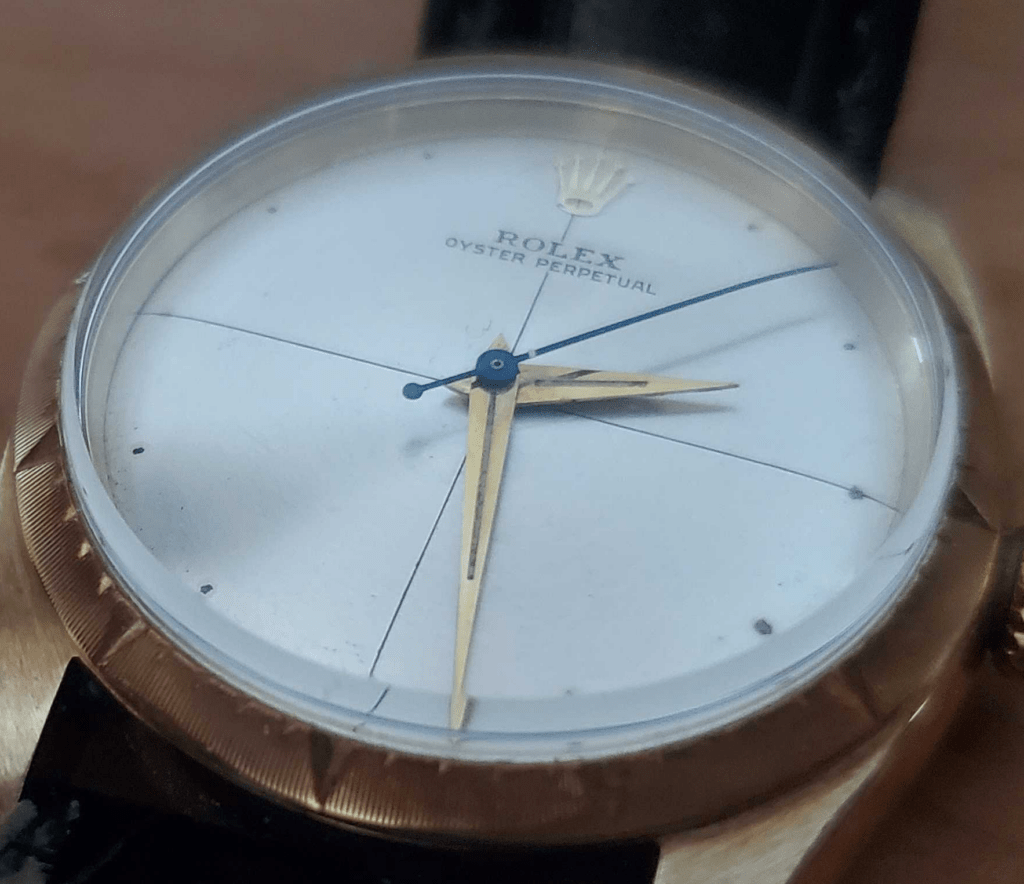
What is a Rolex Bezel?
A watch bezel sits on top of the watch case, surrounding and protecting the crystal. Some bezels are functional, while others are purely decorative. Some are fixed in place, while others rotate. Rolex bezels are famous yet often overlooked as one of the most visually distinguishing parts of a watch.
Rolex has managed to create a wildly successful lineup that, upon examination, has surprisingly little variation aside from the bezels. For example, every watch in Rolex’s 2023 lineup except one (the 1908) has an Oyster case with a fairly standard round shape, stick or Mercedes hands, and similar lugs. Given that Rolex only makes four bracelet styles (Oyster, Jubilee, President, and Oysterflex) which are used across collections, the bezel style is often the primary visual differentiator between their models.
Standard Rolex Bezel Types
The four “standard” types of Rolex bezels are:
- Smooth bezel
- Domed bezel
- Engine-turned bezel
- Fluted bezel
Other Rolex Resources:
How to Spot a Fake Rolex: The Ultimate Guide
The Most Popular Rolex Watches
New and Discontinued Rolex Watches for 2023
Collector’s Guide to Every Rolex Dial
Smooth Bezel
The simplest of all Rolex bezels, smooth bezels have a straight slant. Smooth bezels can be seen on models like the steel Rolex Datejust 41, ref. 126300.

Domed Bezel
Although the terms “domed” and “smooth” are often used interchangeably, they’re actually not the same thing. Domed bezels are more curved, as seen on the Datejust 36 ref. 126200.

Engine-Turned Bezel
If something is made with engine-turning, or “guilloché,” that means some sort of rotating machine is repetitively engraving/cutting a pattern. When a repeating texture or pattern is cut into a dial, it’s usually called “guilloché” while collectors typically refer to such bezels as “engine-turned,” even though it’s the same process.
Note that Rolex’s fluted bezels are technically engine-turned, but for whatever reason Rolex nerds tend to put “fluted” in its own category separate from the engine-turned group. For now let’s go over the various Rolexes that collectors refer to as “engine-turned.”
Sloped Engine-Turned Bezel
The last Rolex with an engine-turned bezel, ref. 115210, was discontinued in 2016. Like the smooth bezel of the Datejust 41, its bezel tapers down outward from the crystal. This can also be seen on older models like ref. 6565.
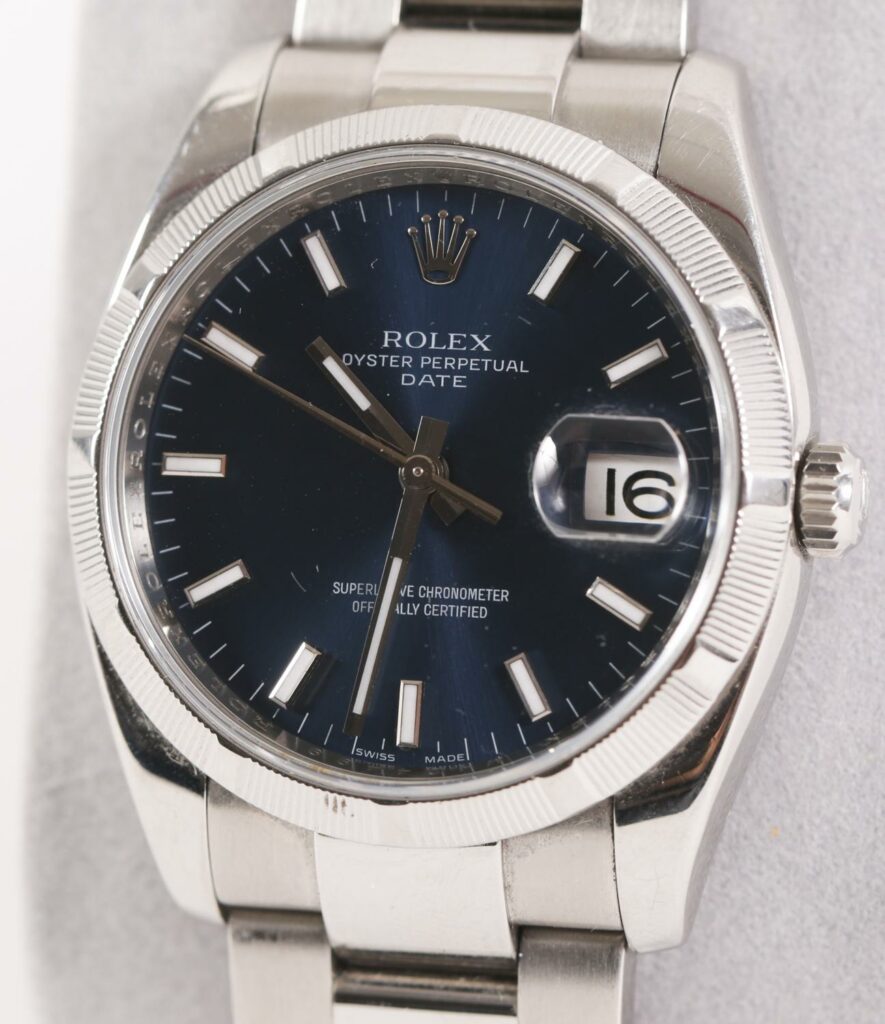
Photo credit: iGavel Auctions
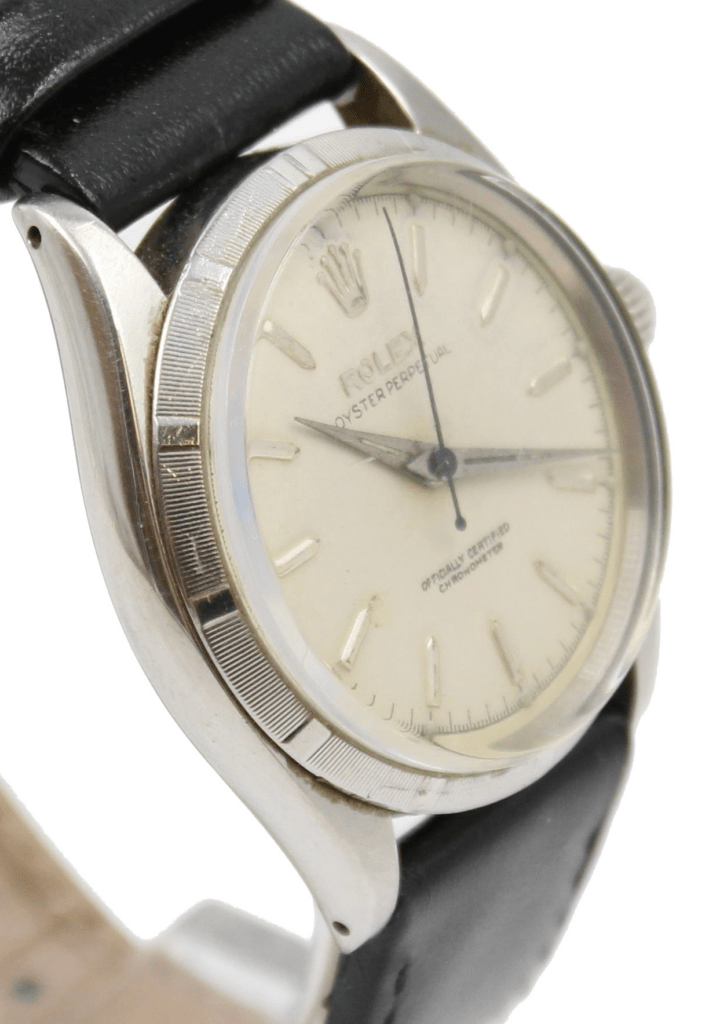
Flat Engine-Turned Bezel
Some engine-turned bezels are flat across the top, rather than sloped. They can be found on the Oyster Perpetual ref. 6569, and they were applied to various other models like ref. 15210 until the early 2000’s. Although most of these flat engine-turned bezels have smooth rectangles at each hour, some examples from the 1930’s-1940’s have circular hour markers that give it a “porthole” vibe.

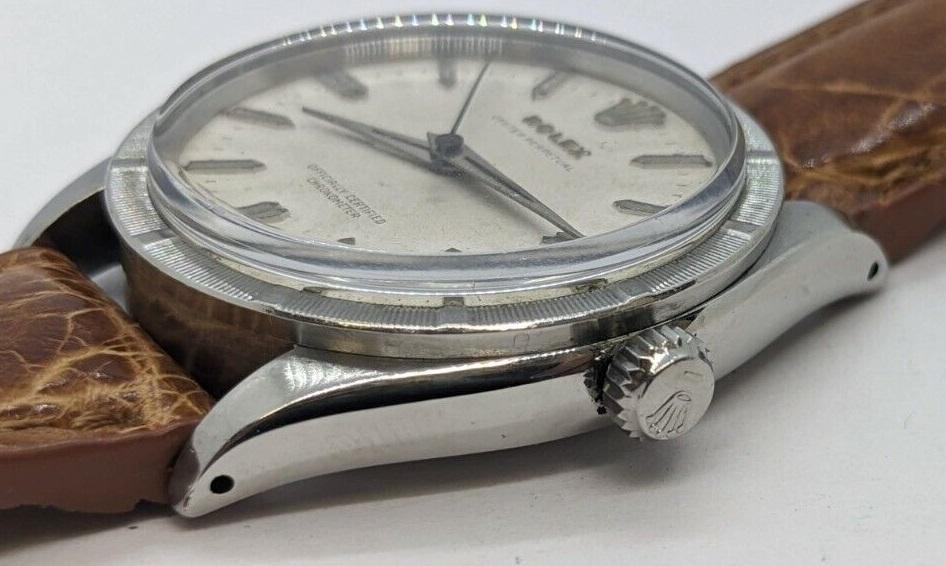
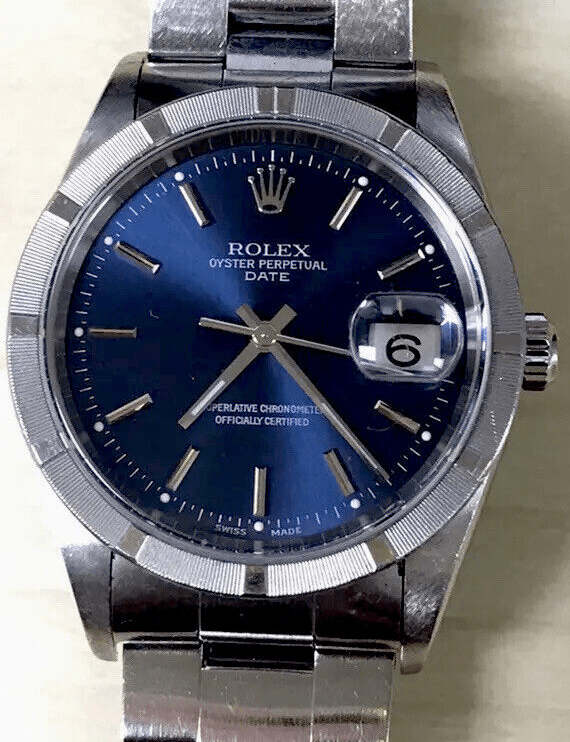
Fully Hashed Engine-Turned Bezel
Engine-turned bezels with markings at every minute (instead of every hour) were made for at least 6 Rolex references: 1603, 16030, 16220, 1505, 15053, and 15223.
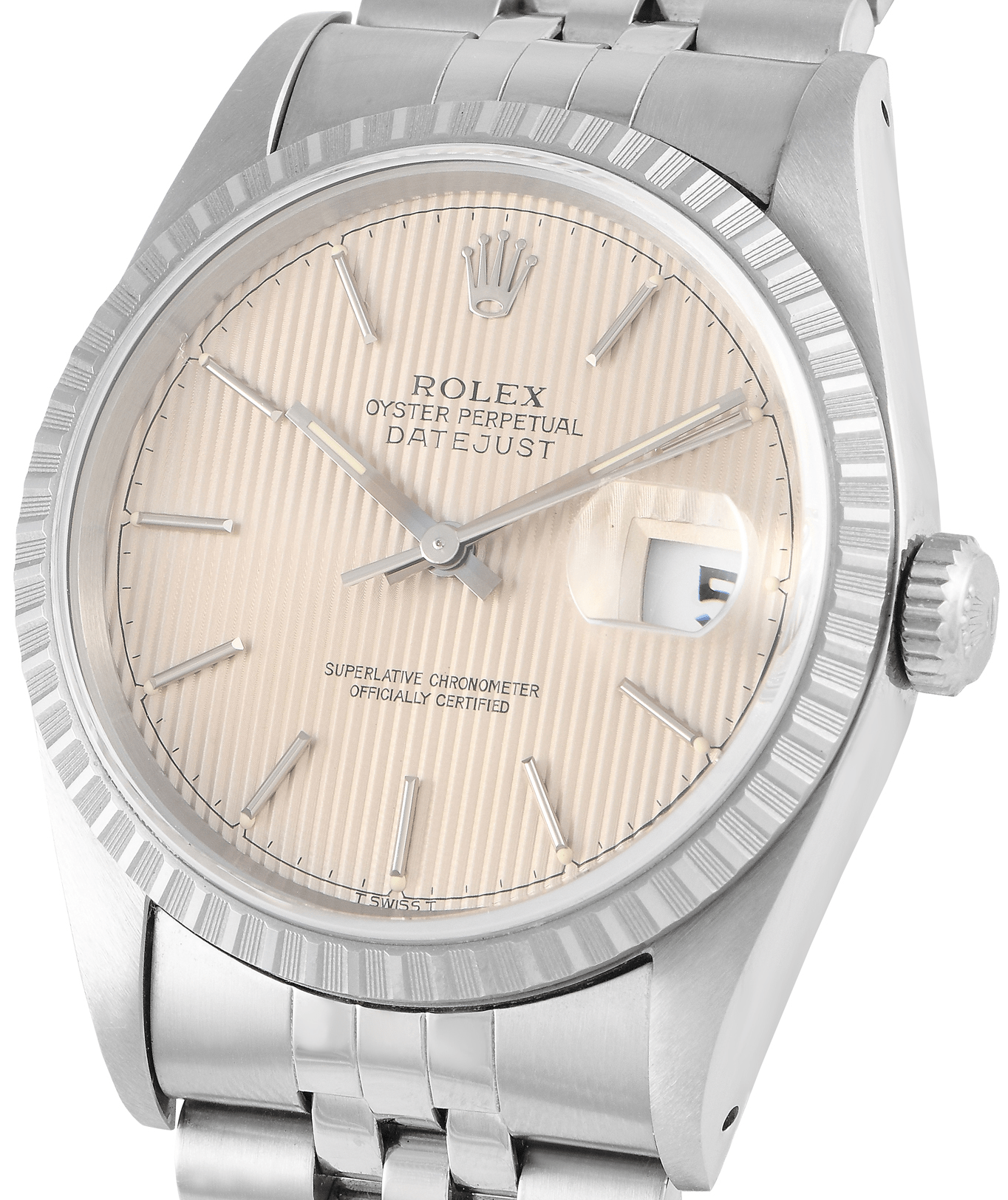
Fluted Bezel
The fluted bezel is undoubtedly Rolex’s most iconic bezel texture. Often imitated, Rolex’s fluted bezel first appeared on the Datejust in 1945 and has been a big part of Rolex’s design language ever since. Fluted bezels are fixed in place–except on the Sky-Dweller, which has an impressive and patented “Ring Command” feature that uses the bezel to set the time.
Historically, fluted bezels were exclusively solid gold. Platinum is much harder to machine, but finally in 2022 Rolex added fluted platinum bezels to the Day-Date lineup.
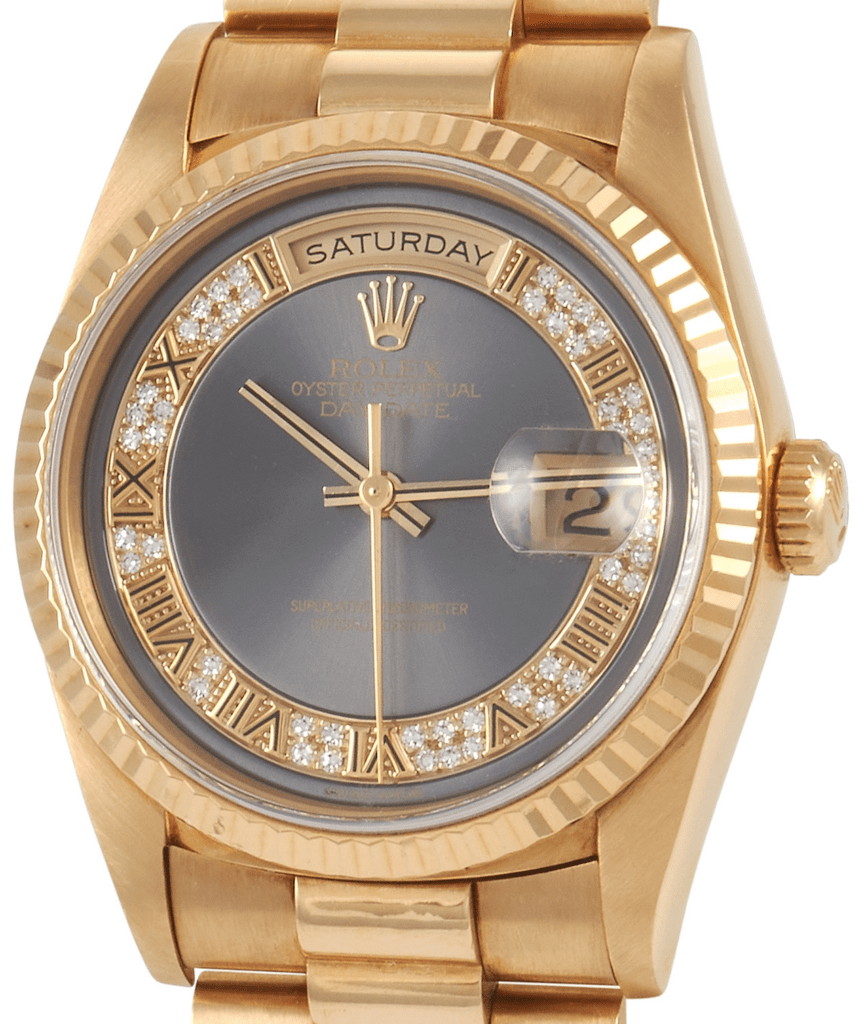
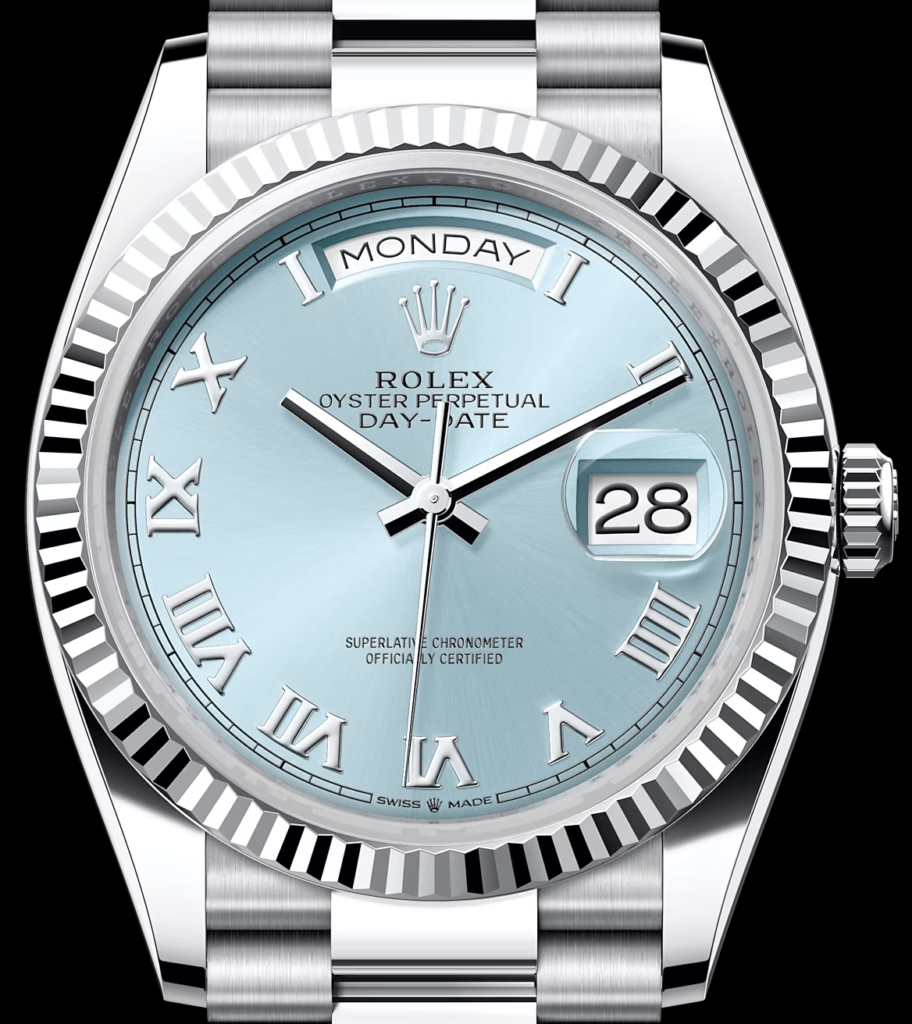
That’s it for Rolex’s most basic bezel styles. Next we’ll go through the functional bezels found on Rolex sports models (or “Professional” models as Rolex calls them).
Professional/Sports Rolex Bezels
With the introduction of the Rolex Submariner in 1953 and the GMT-Master the following year, Rolex made purpose-built professional bezels an important part of their lineup. Earlier “sports watches” were entirely focused on resistance to shocks, moisture and dust. A simple Rolex Oyster Perpetual was the very definition of a “sports watch” 80-90 years ago, although nowadays that term (somewhat arbitrarily) essentially has come to refer to watches with large, numbered bezels. Let’s go over all of the types of numbered bezels used on Rolex Oyster models:
60-Minute Bezels
Rotating bezels with markings designed to time intervals in minutes are ubiquitous on dive watches now, but the Submariner actually wasn’t the first Rolex with such a bezel. That honor belongs to an obscure monopusher chronograph prototype from 1937.
Centregraph/Zerographe Bezel
Ref. 3346 was sometimes labelled as “Centregraph” and other times “Zerographe.” An American named Phillip Weems had a patent for a rotating bezel which he sold to Longines, whose “Weems Watch” was first gaining steam around the time this reference was made. Perhaps patent infringement was the reason Rolex never seemed to reach the full production stage for this model. In any case, only a handful are known to exist, and they have steel bezels with hash marks at every minute. The red bezel accents are a nice touch.
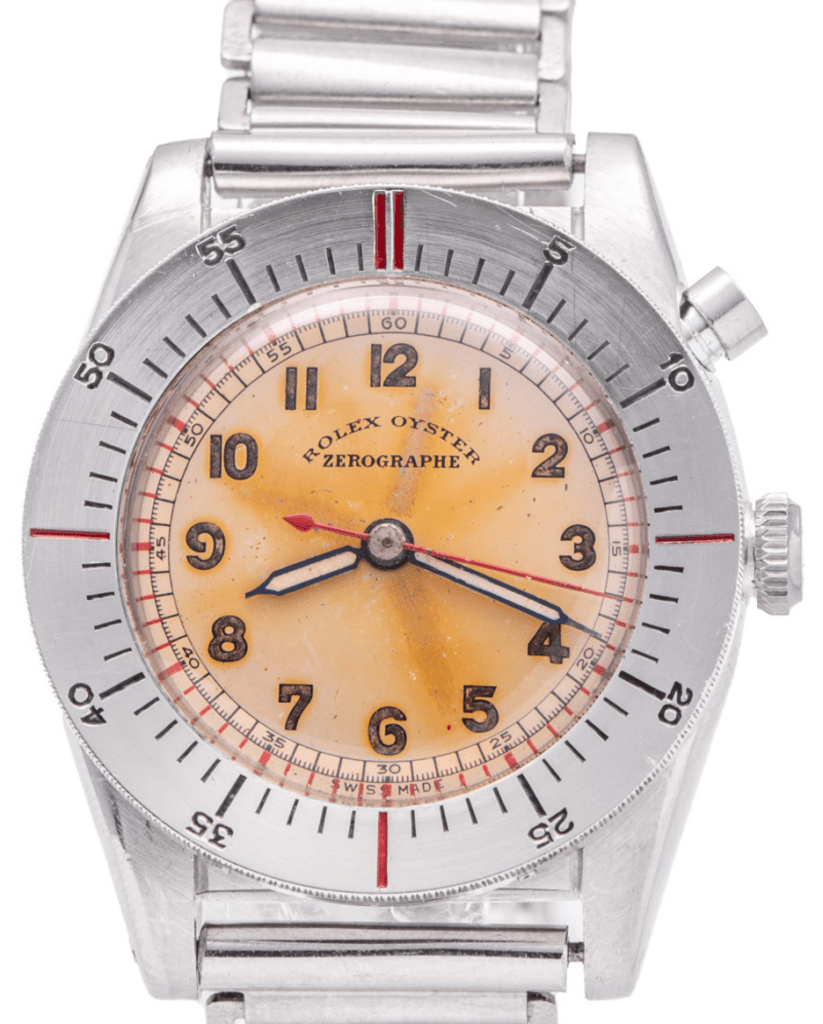
Early Turn-O-Graph Bezel
Rotating bezels designed to measure up to 60 elapsed minutes aren’t just for dive watches. In fact, Rolex released their Turn-O-Graph before the Submariner. Some of the earliest examples have red triangles at 12 o’clock and dots rather than hashes. The first fonts were less blocky than the iconic Submariner bezel font we know today. Turn-O-Graph bezels are all bidirectional.
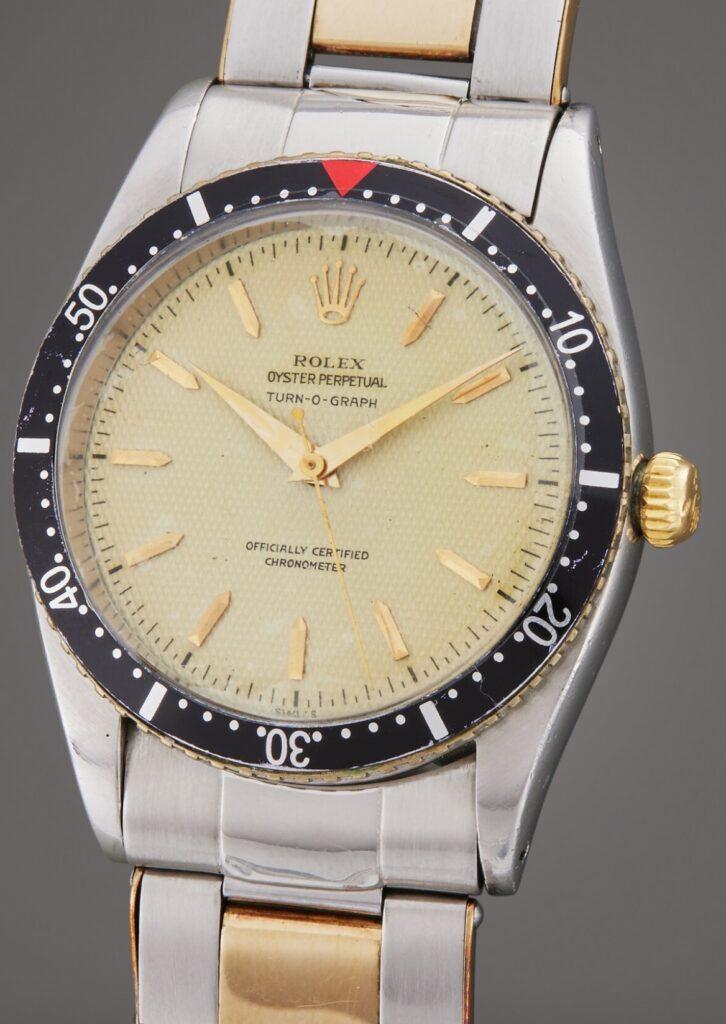
Rolex Turn-O-Graph ref. 6202 circa 1953. Photo credit: Sotheby’s
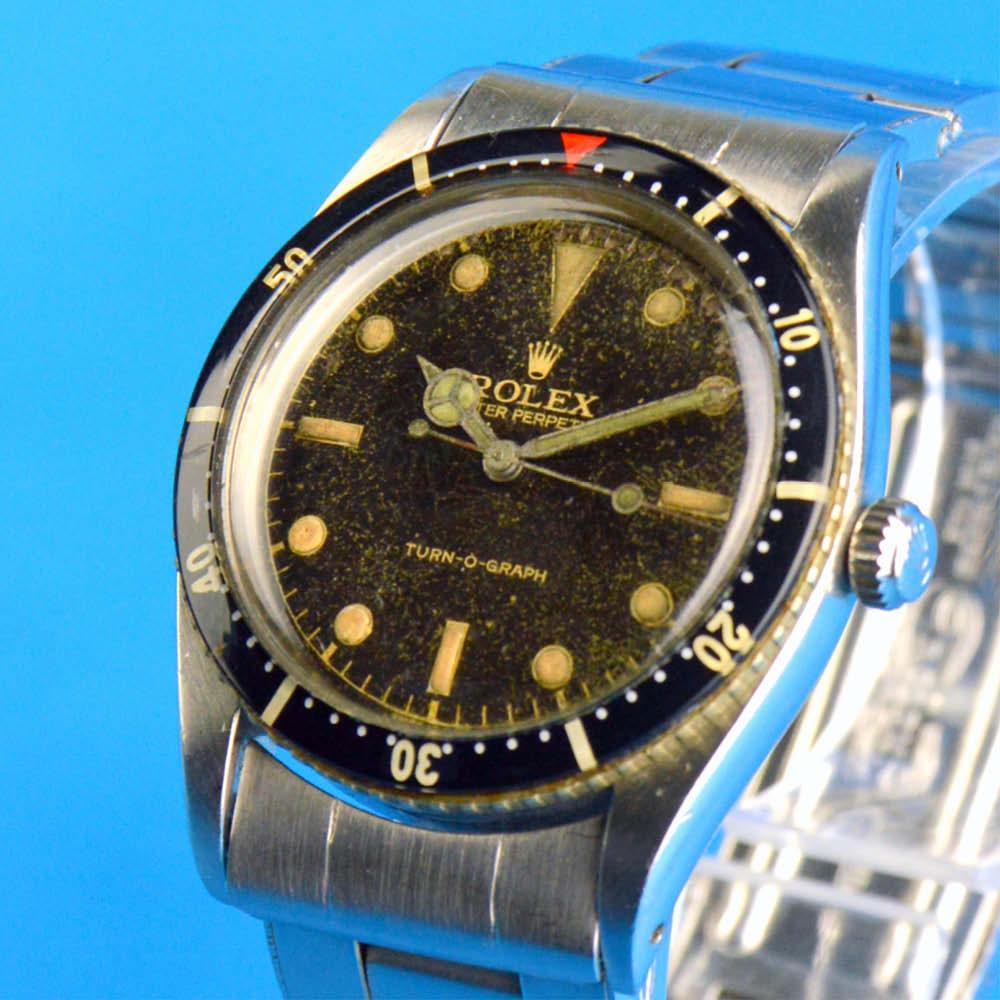
Photo credit: wanted-watch.com
Gold Turn-O-Graph Bezel
From the time the Turn-O-Graph evolved past its Submariner-lookalike roots until its discontinuation in 2011, it sported a yellow gold or white gold engine-turned bezel with applied 10-20-30-40-50 numerals.

“No-Hash” Bezel (Submariner/Milgauss)
Some of the very first Submariner and Milgauss bezels lacked hash marks for individual minutes.
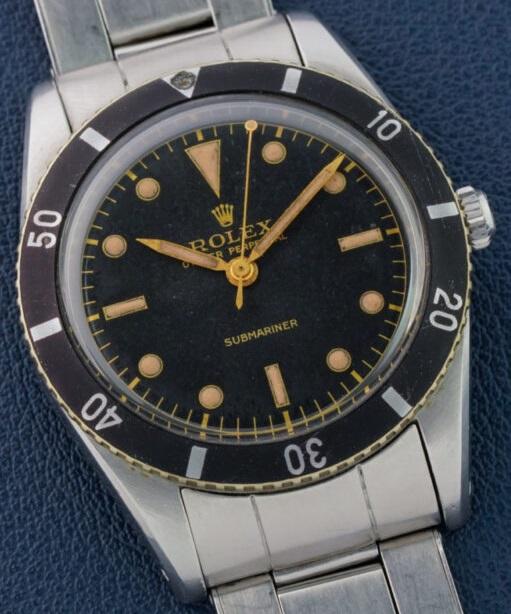
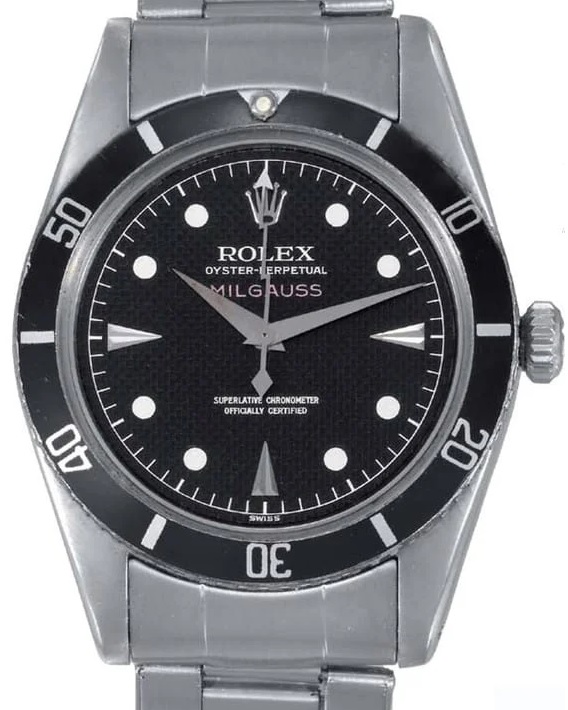
Submariner Bezel (Dive Bezel)
As with early Turn-O-Graphs, a few early Submariner bezel inserts have red triangles at the top. Those are extremely desirable. Aside from that, Submariner bezels will typically look like this, with marks every five minutes, numbers every ten minutes, and hashes for the first 15 minutes. This represents the 15 minutes of air a diver would expect to have in his tank.

Fully Hashed Dive Bezel (Sea-Dweller/Mil-Sub Bezel)
Sea-Dwellers, like some military-issue Submariners, have bezel hashes at every minute.
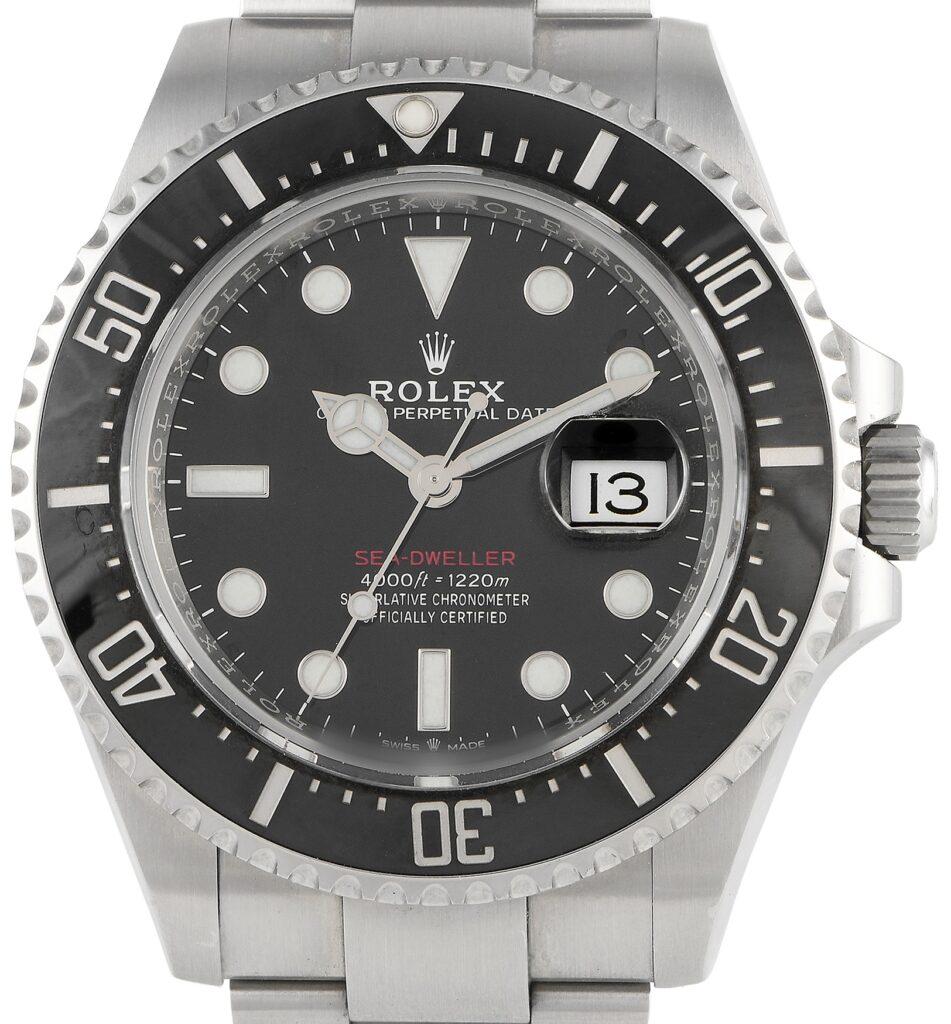
Photo credit: Luxury Bazaar
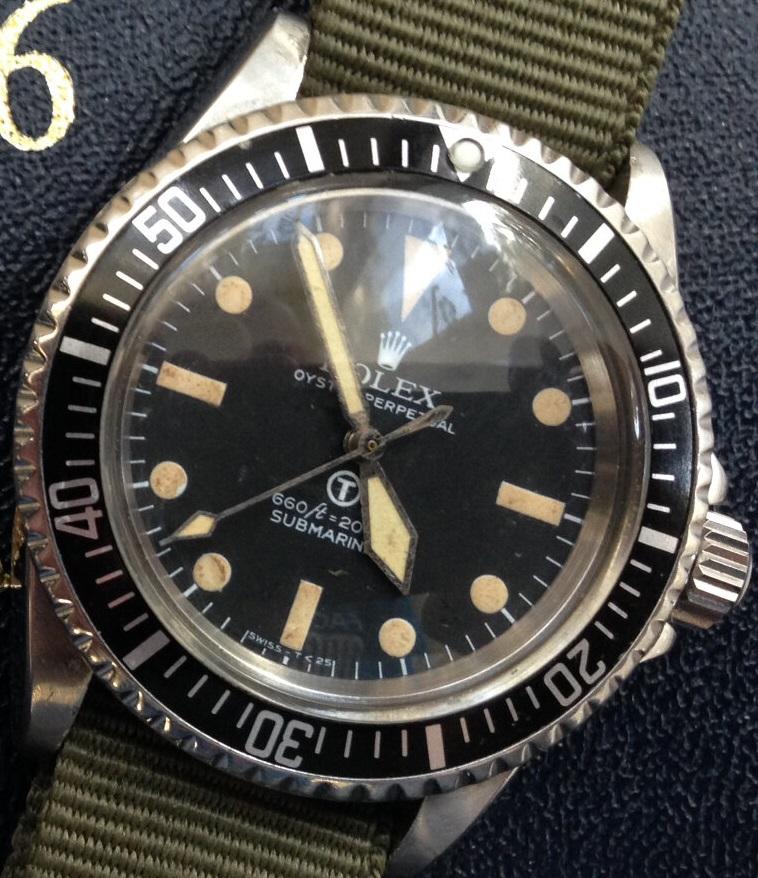
“No-0” Milgauss Bezel
This bezel looks odd to some at first, but it’s simply a fully hashed bezel where the 0’s are…implied. Some very rare early Milgauss 6541’s have this.

Yacht-Master Bezel
The Yacht-Master bezel is pretty much an aggressive but fancy Submariner bezel. It has big applied numbers instead of printed ones. Yacht-Master bezel inserts are made out of gold, platinum or ceramic.

Yacht-Master 2 Bezel (Countdown Bezel)
The only Rolex so far to have a countdown bezel is the Yacht-Master II, an under-loved model that first debuted in 2010. The YM2 has a functional bezel used when setting the 10-minute countdown timer. Horologically, this watch is one of Rolex’s greatest achievements, but often people pay more attention to its large size and unusual bezel than to the movement.
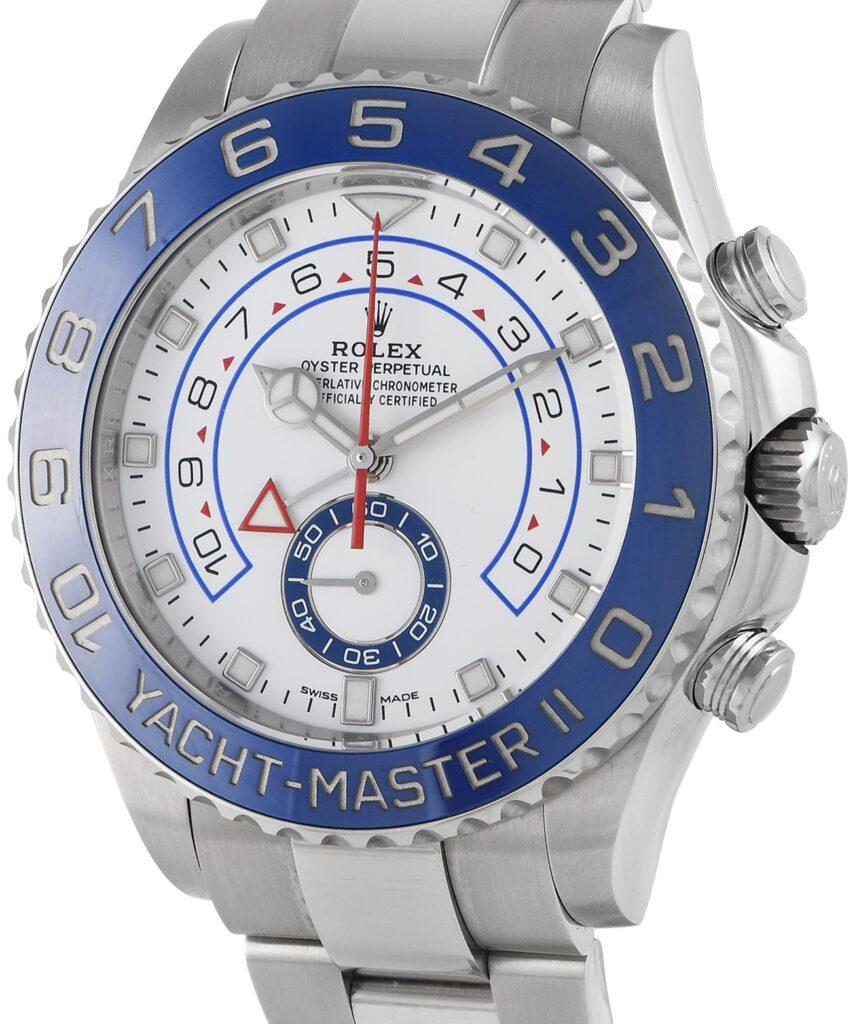
Hour Bezels
Glycine is actually the watch brand credited with releasing the first 24-hour watch bezel in 1953, not Rolex. Rolex followed closely behind.
GMT-Master Bezel (24-Hour, Rotating)
The GMT-Master debuted in 1954, with its own iconic rotating 24-hour bezel designed to track a second time zone. Unlike the Glycine Airman, however, it featured a normal 12-hour scale for its hour hand, and an additional hand for 24-hour functionality. The first examples of Rolex GMT-Masters had Bakelite bezel inserts, which were fragile and risked exposing the radium underneath. Those were quickly replaced by aluminum bezel inserts, which were in turn superseded by ceramic inserts when Rolex’s 6-digit models were released in the 2000’s.
More on GMT’s:
What is a GMT Watch?
What is a Rolex Root Beer?
What is the Rolex Pepsi?
Best Rolex GMT-Master Alternatives
What is a Rolex Coke GMT?
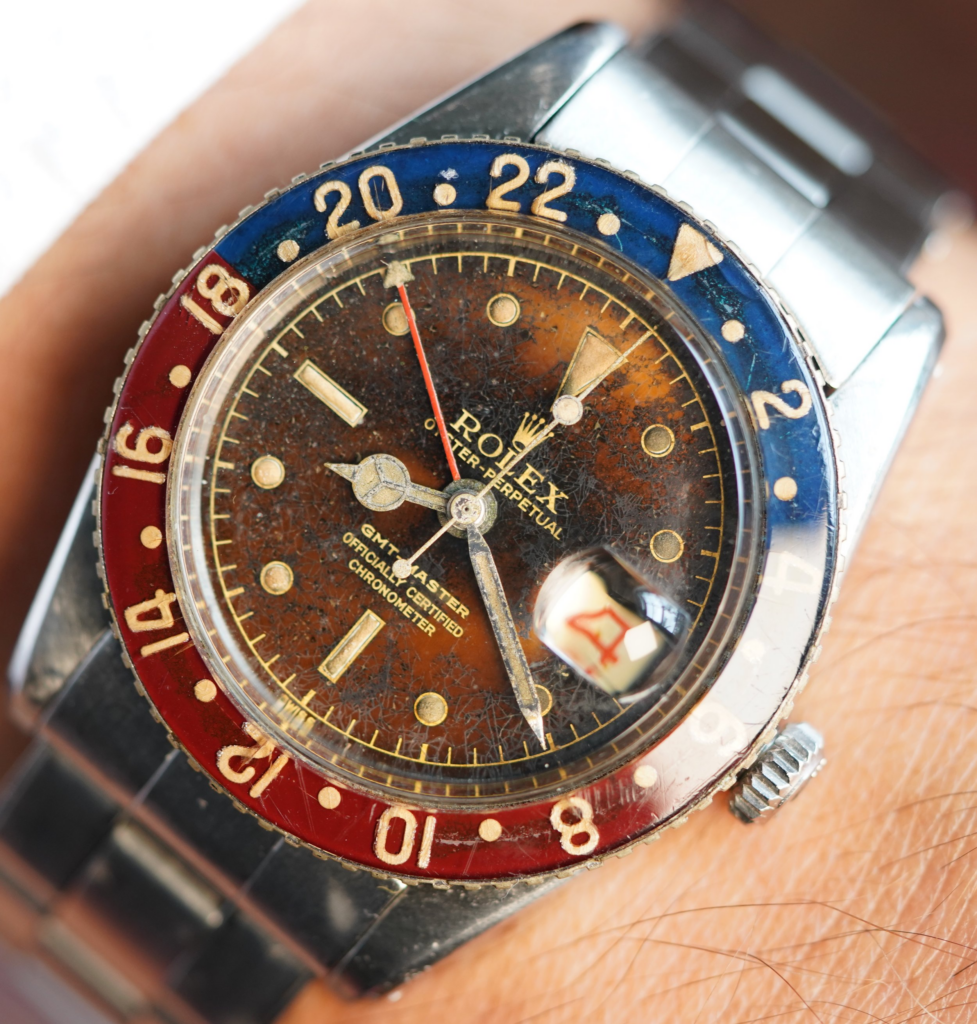
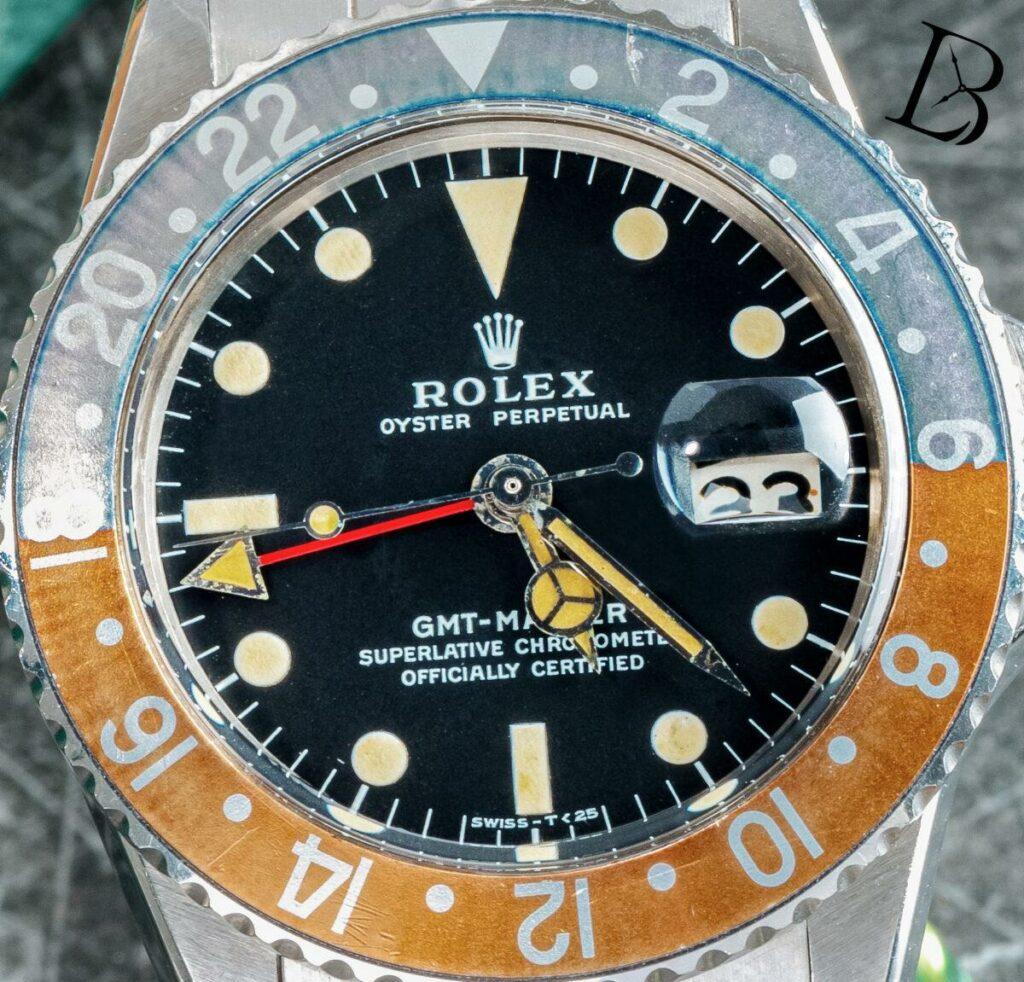
Rolex GMT-Master ref. 1675. Photo credit: Luxury Bazaar
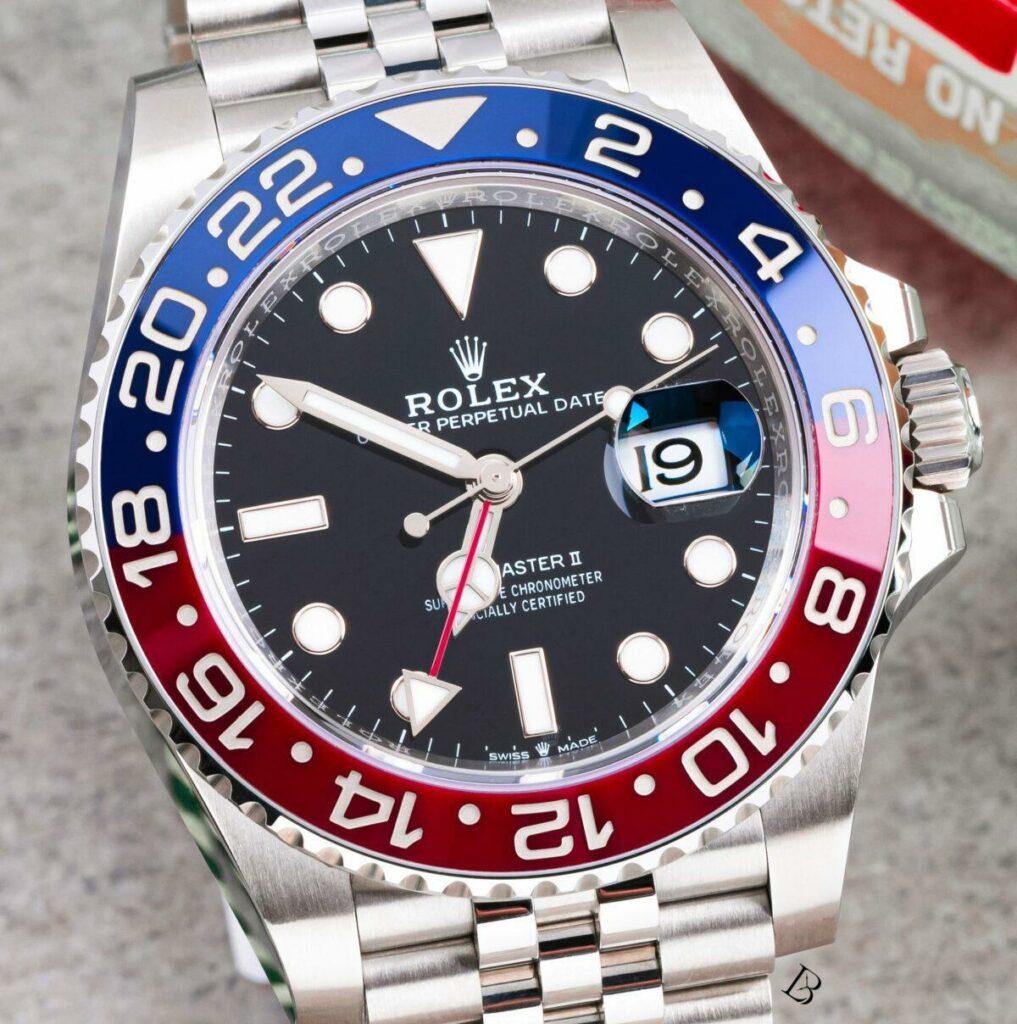
Explorer II Bezel (24-Hour, Fixed)
Unlike the GMT-Master and GMT-Master II, the 24-hour bezel of the Explorer II is fixed. The first Explorer II, ref. 1655, had a fixed 24-hour hand too, which meant the bezel was really just a day-night indicator rather than a second time zone. The watch was marketed at spelunkers, so that made sense, but later models received an independent 24-hour hand.
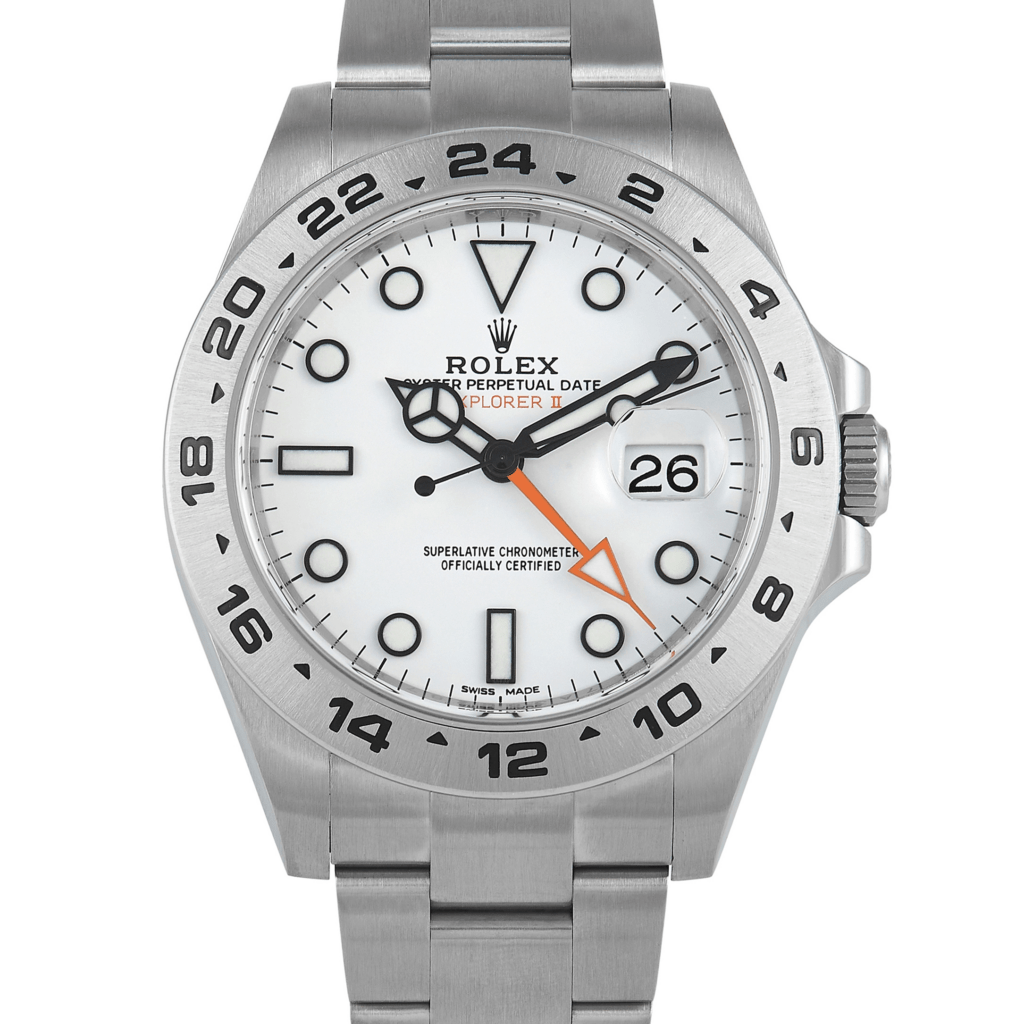
Transcontinental Bezel (12-Hour, Rotating)
Some collectors may not be aware that Rolex also has made a 12-hour bezel before. It only came on one Rolex model, the spectacularly obscure Datejust Transcontinental ref. 6602 from 1957.

Daytona Bezel (Tachymeter)
Rolex made many chronograph references throughout their first 5 decades as a company, but none were big hits. Once the Omega Speedmaster became popular, Rolex also adopted the tachymeter bezel idea for their own chronographs, which they then began calling “Cosmographs.” While some early examples just say “Cosmograph,” the “Daytona” moniker was added shortly thereafter.
Some early Rolex Daytona bezel inserts were made of Bakelite, but 5-digit models’ bezels were only steel or gold. Note that white gold and rose gold Daytonas–as well as yellow gold models that came on a strap–always have concentric bezel numbers rather than upright. Ceramic bezel inserts first entered the Daytona lineup in 2008 on the rose gold ref. 116515, but ceramic didn’t become standard on steel Daytonas until 2016. Daytonas have been particularly hard to purchase at retail ever since.
More on the Daytona
The Best Rolex Daytona Alternatives
The Rare and Cheerful Rolex Daytona Beach Collection
Rolex Unveils the LeMans Daytona
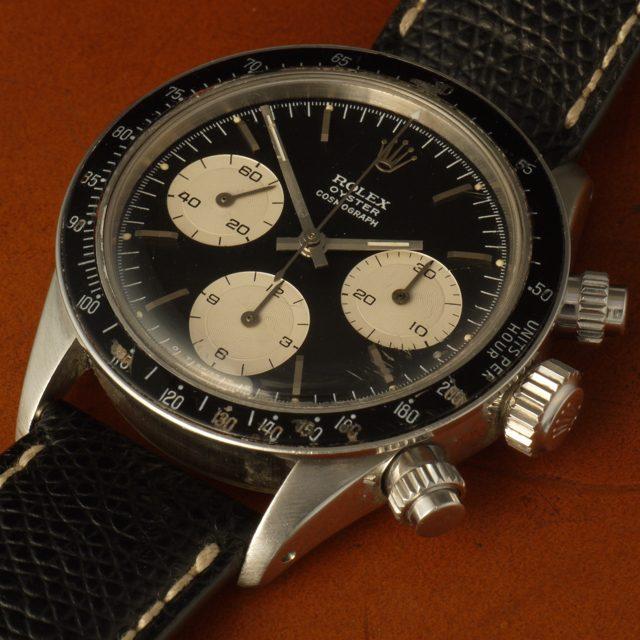
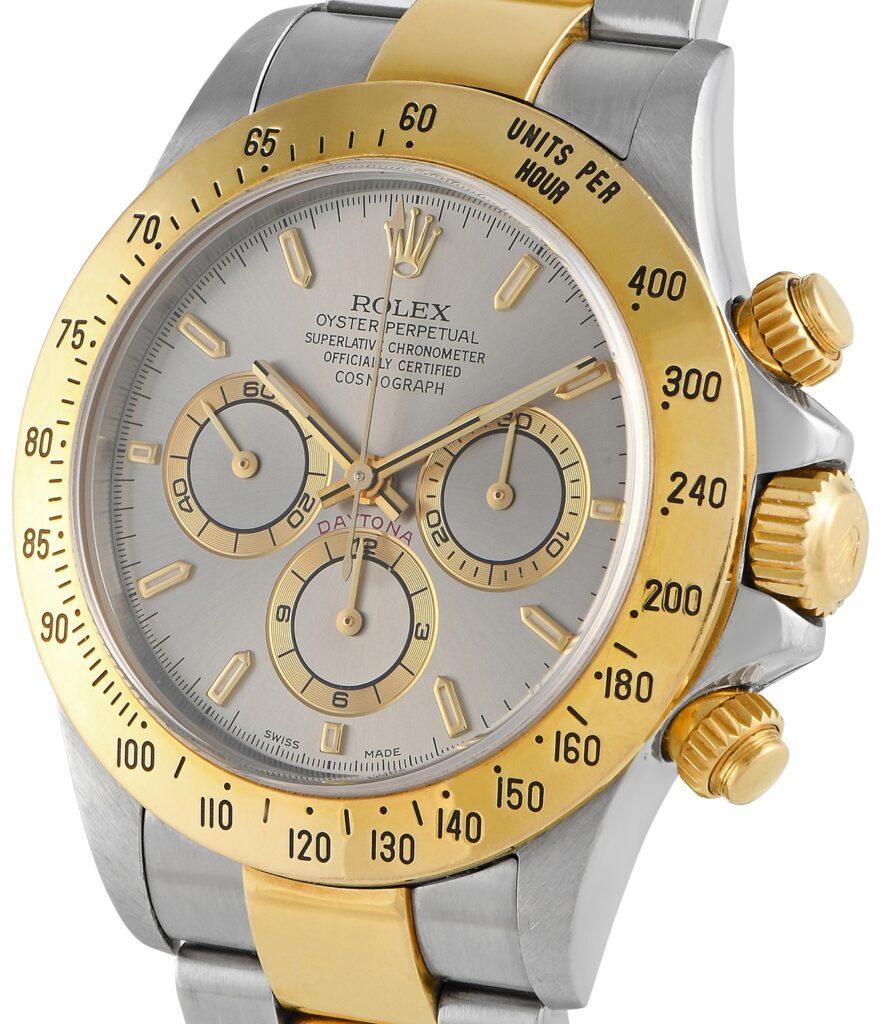
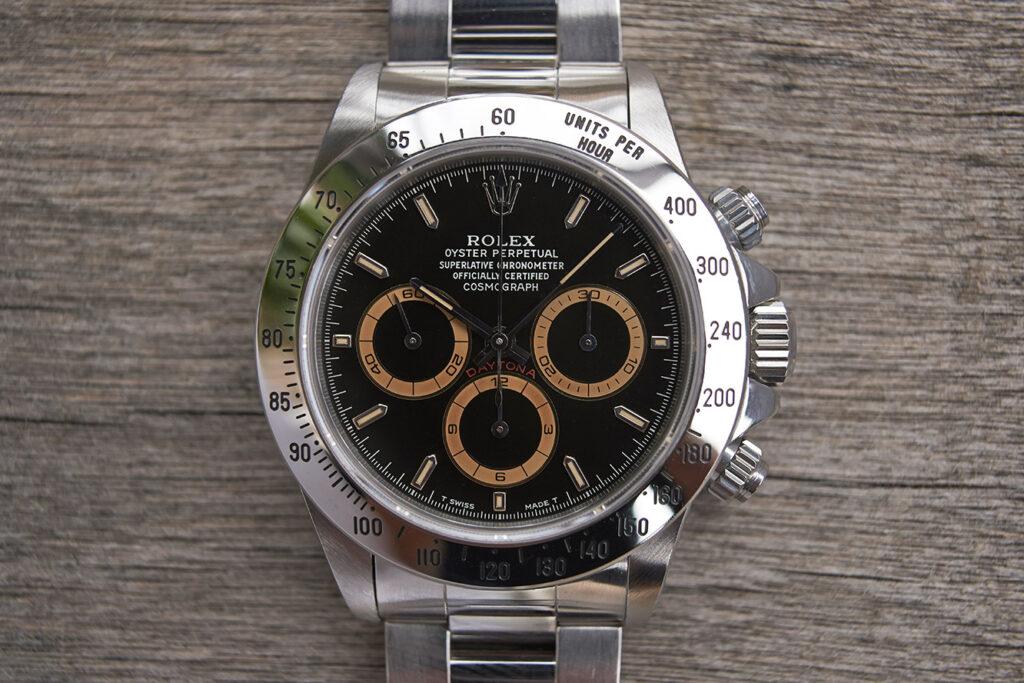
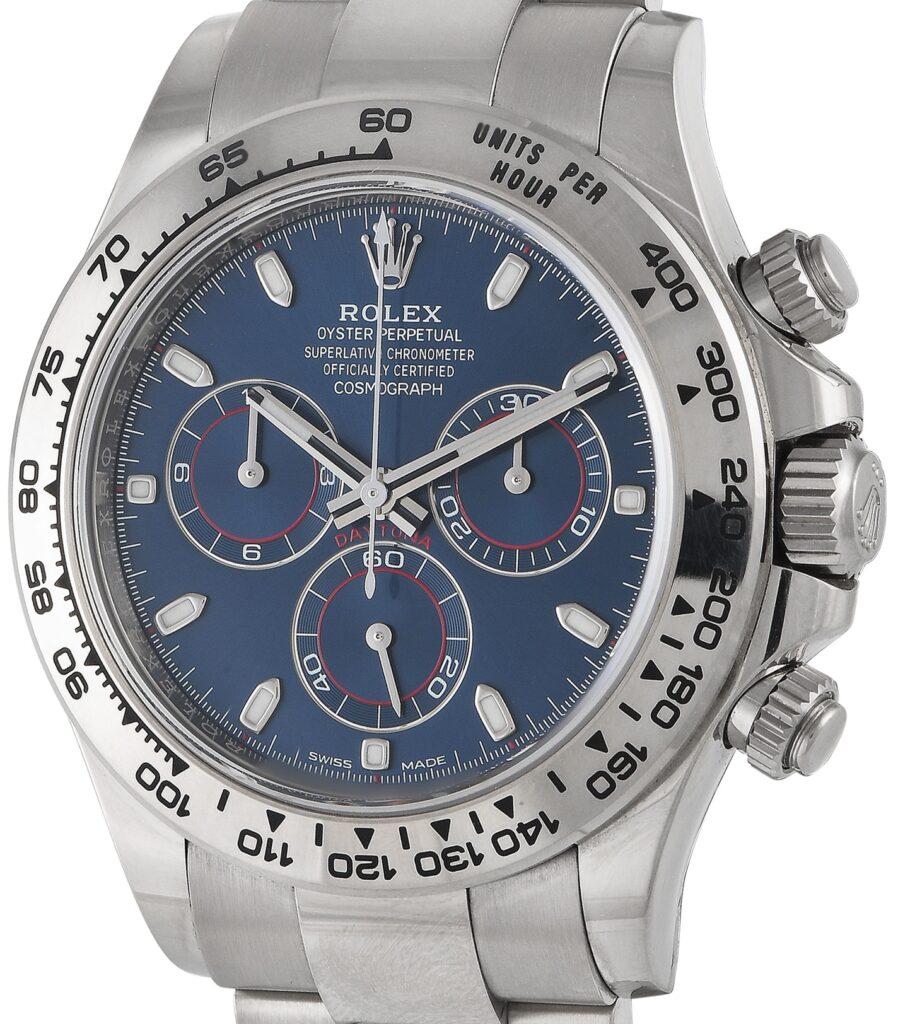
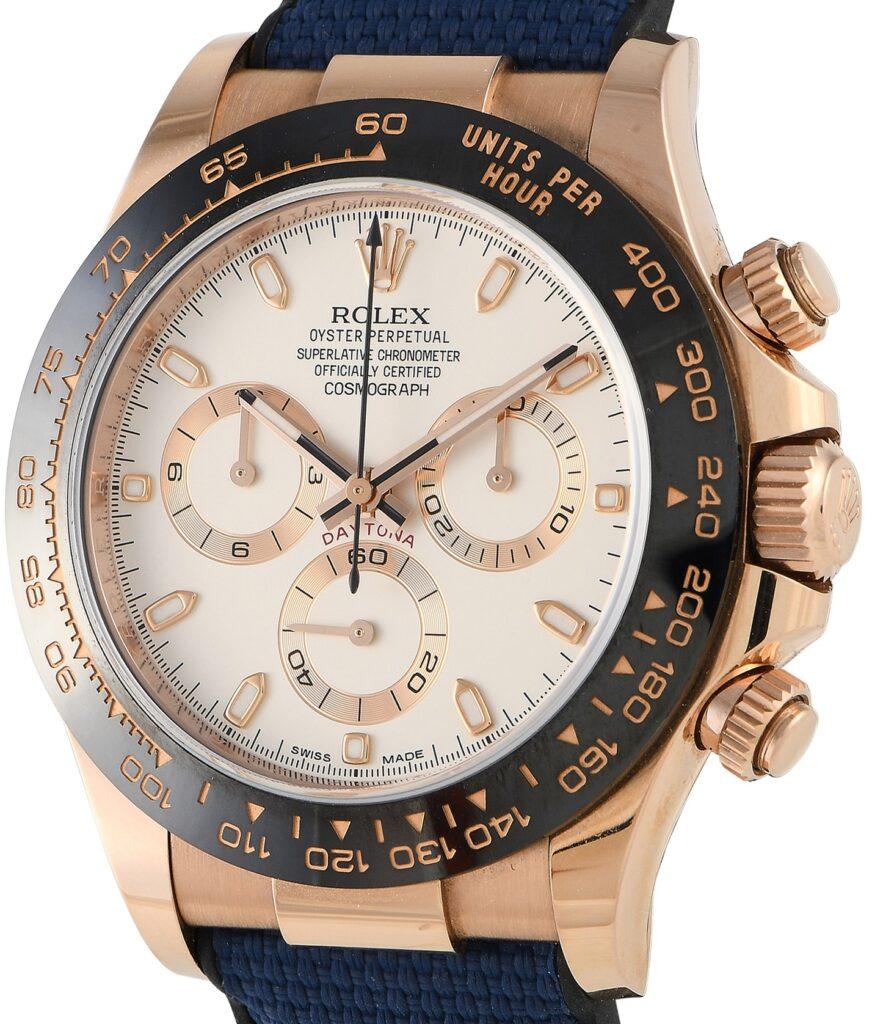
Rare Rolex Bezels
Any Rolex collector will know the difference between a smooth bezel and a fluted bezel, but there have been some less-celebrated Rolex bezel styles over the years, too: checkerboard bezels, scooped bezels, scalloped bezels and more.
Discontinued Vintage Rolex Bezels
Now that we’ve covered all the basic and Professional Rolex bezel styles, let’s revisit some more obscure bezels, all discontinued over 50 years ago.
Coin-Edge Bezel
The precursor to Rolex’s famous fluted bezel was the coin-edge bezel. This can be seen on Rolexes from the 1920’s-1940’s. Rolex’s 1922 attempt at a waterproof watch, a hermetic watch called the Submarine with a primitive “case-in-a-case” design, had its winding crown located inside the outer case.
Therefore it was necessary to unscrew the bezel regularly to access the inner watch, and the added grip of the coin-edge texture was a matter of practicality. Although this unscrewable bezel design did not last long, the coin-edge bezel aesthetic had some staying power, and it can be found on early Oysters (late 1920’s) and even some of the first Datejusts (mid-1940’s). Notice how the texture matches that of its Oyster caseback. Coin-edge bezels can be found in steel, yellow gold, or rose gold.
For More on Rose Gold: Guide to Every Rose Gold Rolex

Bamboo Bezel
Although the Datejust ref. 1603 usually has a fully hashed type of engine-turned bezel, some examples from 1959-1962 have an alternate style known as a “bamboo bezel.” Interestingly, bamboo bezels only seem to come with silver dials and either dauphine or alpha hands.

Checkerboard Bezel
The bamboo bezel was the successor to another rare obscure style of steel engine-turned bezel: the checkerboard bezel. It appeared on Datejust ref. 6305 and 6605 from about 1953-1959.

More on Rolex
How Much Does a Datejust Cost?
Rolex Buys Bucherer: All About the Acquisition
Rolex Watches Discontinued in 2022
Best Rolex Explorer Alternatives
Scooped Bezel
Scooped bezels are basically the inverse of domed bezels–they have a concave curve rather than convex. Since smooth, domed, and scooped bezels can be confusing, here’s a diagram:

Scooped bezels can be seen on ref. 4444 and 6044 from the 1940’s-1950’s.

Flat-Top Bezel
Another rare and often overlooked type of Rolex bezel is the flat-top design that can be found on references like the 3595 Bubbleback. At first glance it is similar to a typical smooth bezel, but instead of a straight slant down from the crystal to the case, it has a distinctly flat surface with vertical edges.
The bezels on Rolex’s straight-lug Oyster Perpetuals from the 1940’s, known as “Empire” or “Athlete” models, are also in the flat-top style.

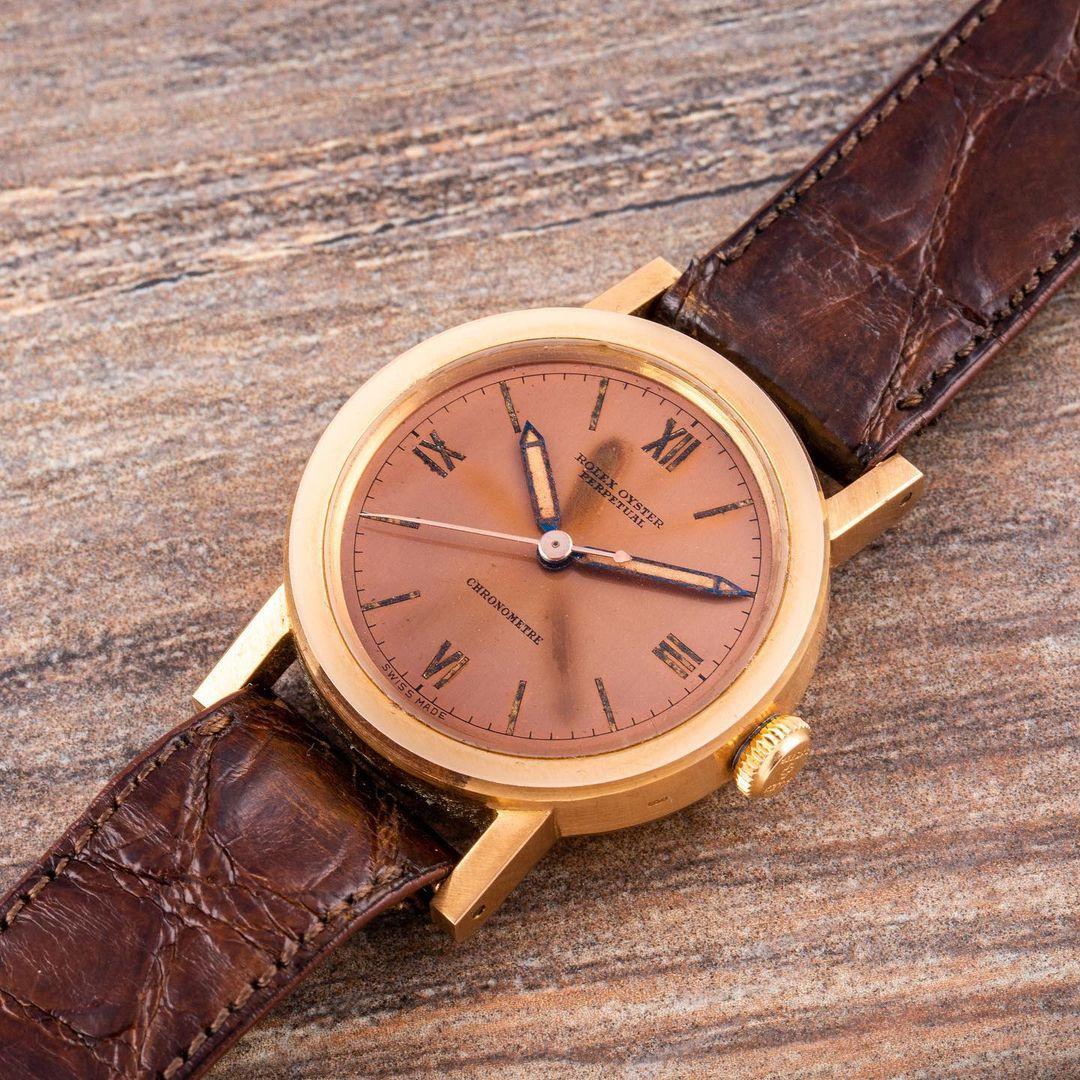
Lifesaver Bezel
Extra-wide, flat Oyster bezels from the late 1930’s are sometimes called “lifesaver bezels.” The most extreme examples can be seen on ref. 3190 and 2849, although ref. 3346’s bezel is generally considered a lifesaver as well.



Creased Bezel
An unusual “creased” bezel can be seen on the very rare Bubbleback reference 3980. It’s like the pleated version of a domed bezel.

Faceted Bezel
One of the obscurest bezels found on any Rolex Oyster model is the gold-capped (not solid gold) faceted bezel found only on ref. 1025.

Scalloped Bezel
The term “scalloped bezel” is probably most often associated with the Omega Seamaster 300. Rolex also long ago made watches with a “Bond Seamaster”-esque bezel shape: ref. 6286 and 6586 from the 1950’s.
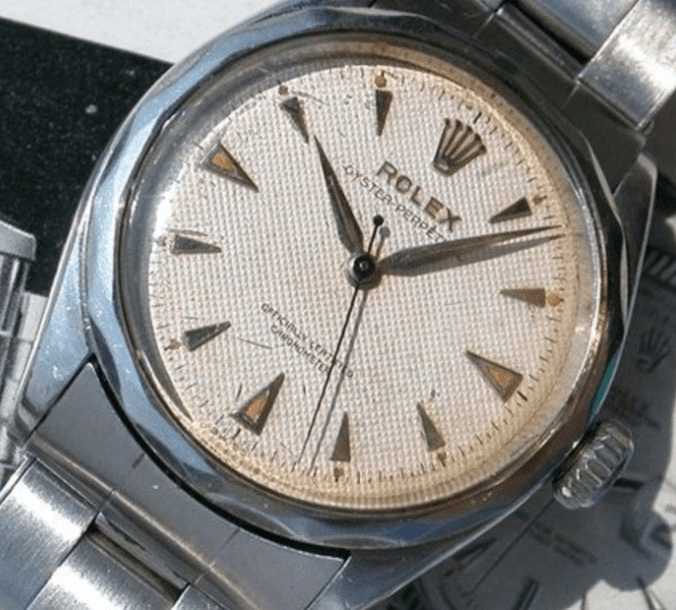

Scalloped + Engine-Turned Bezel
Ref. 6566 is similar to 6286 and 6586, excepts its bezel is basically engine-turned and scalloped. This bezel, like many exotic bezels we’ll show you soon, was only made in solid yellow gold.

That’s about it for rare discontinued Rolex bezels–at least for entry-level models. Rolex actually released a wide variety of rare textured bezels that were only available on full yellow gold models. We’ll show you each one of those now.
Exotic Gold Textured Rolex Bezels
Rolex has used over a dozen distinct, exotic gold textures on its bezels. Sellers often conflate and mislabel them, which is understandable because several of them are so similar. But hopefully we’ll be able to clear it all up! The heyday of these gold textures was definitely the 1960’s-1970’s, just a bit before sports watches went really mainstream. Several of them are exclusive to 34mm Oyster Perpetual Date models.
Barked Bezel
Barked bezels are surely the most well-known of the textured gold Rolex bezels. As the name suggests, the texture evokes tree-like imagery. Some models have smooth markers at each hour while others don’t. Although it’s a very 1970’s-1980’s vibe, barked models were made through the late 1990’s.
Barked Rolexes were made in both yellow and white gold. Note that all of the other textures we’re about to show you were exclusive to solid yellow gold models!
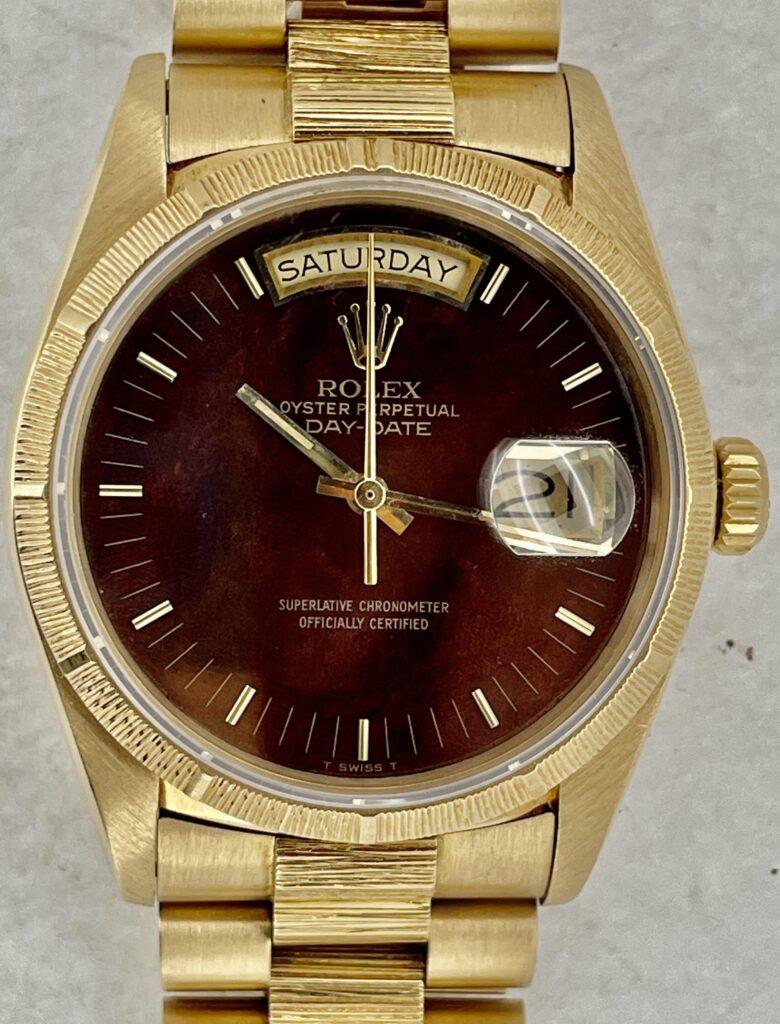
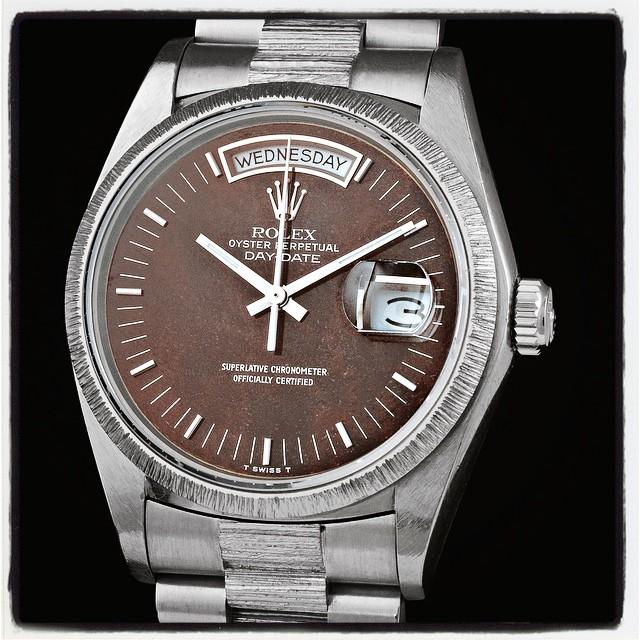
Florentine Bezel
Florentine is probably the second-most well-known gold texture used by Rolex. In fact, it’s the only texture Rolex ever applied to the case of an Oyster model–not just the bezel and bracelet! Although it’s most often seen on the Rolex Day-Date ref. 1806, the Florentine finish has been seen on some other Oyster models as well.
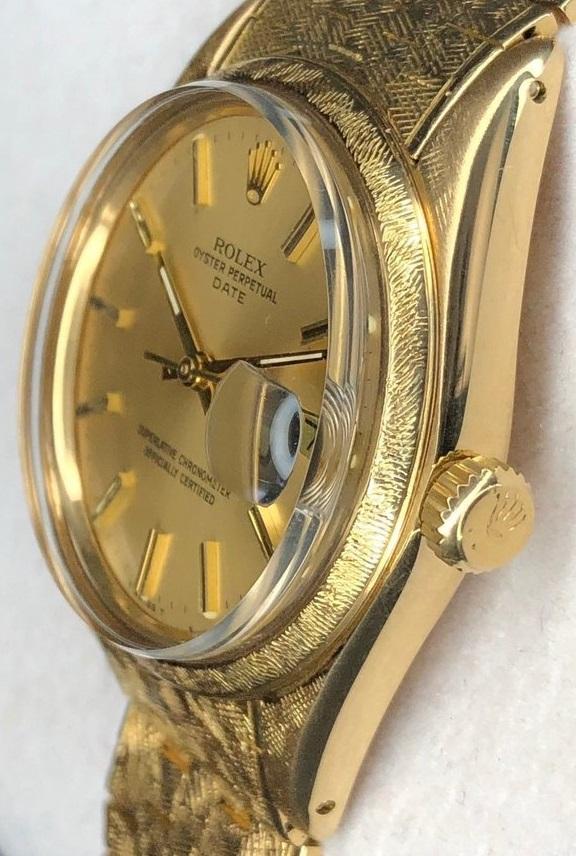
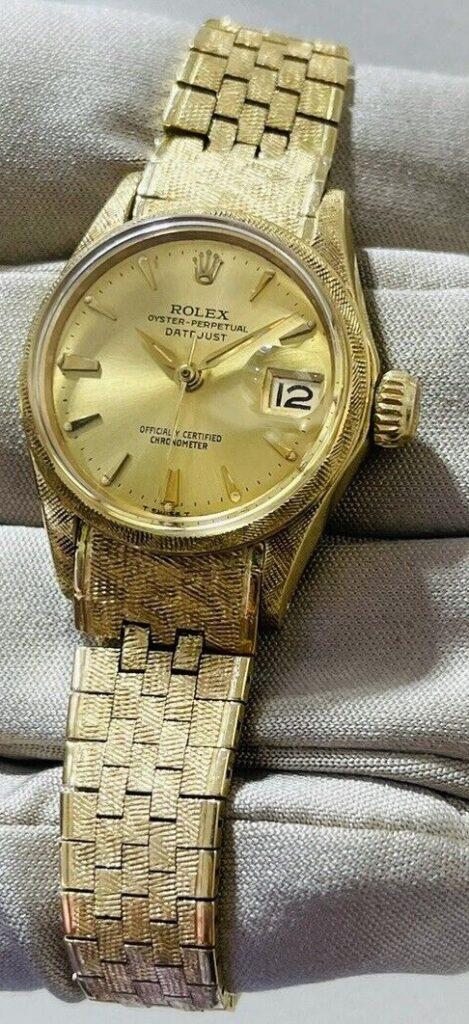
Photo credit: Miami Watch & Jewelry
Zephyr Bezel
The Zephyr is a 34mm Oyster Perpetual (and Oyster Perpetual Date) model with a unique gold bezel, sold only in the US. Some 24mm ladies’ models were made as well. There are two kinds of Zephyr bezels. The ones with “pointy” markers are labeled as “guill fant.” in Rolex literature, while the blockier notches that appear on ref. 1038 and 1512 are known as “guill ind.”
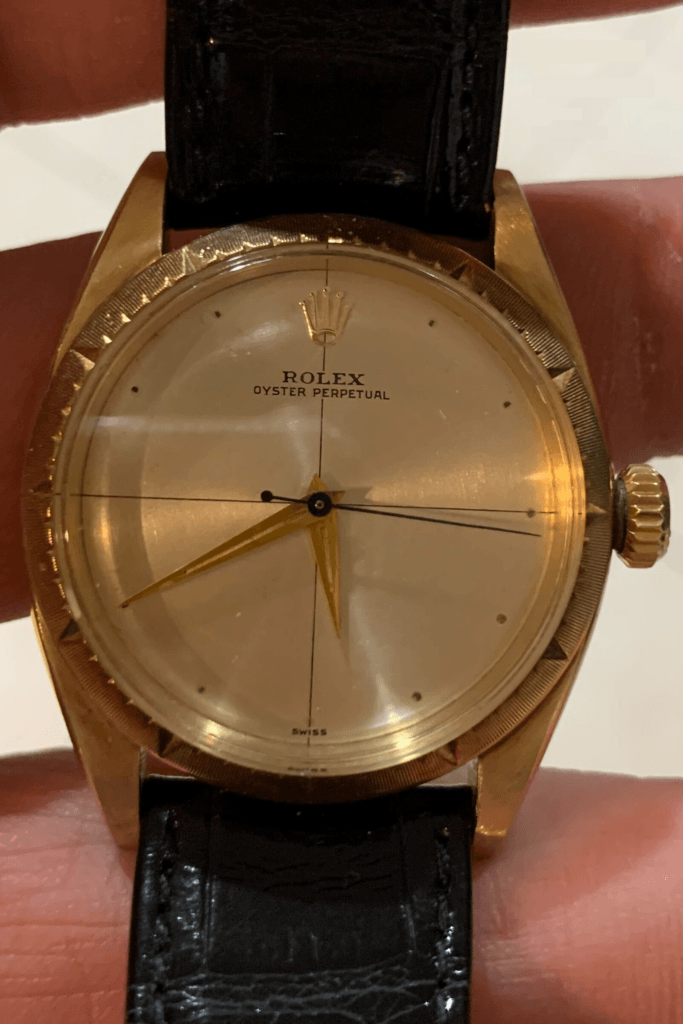
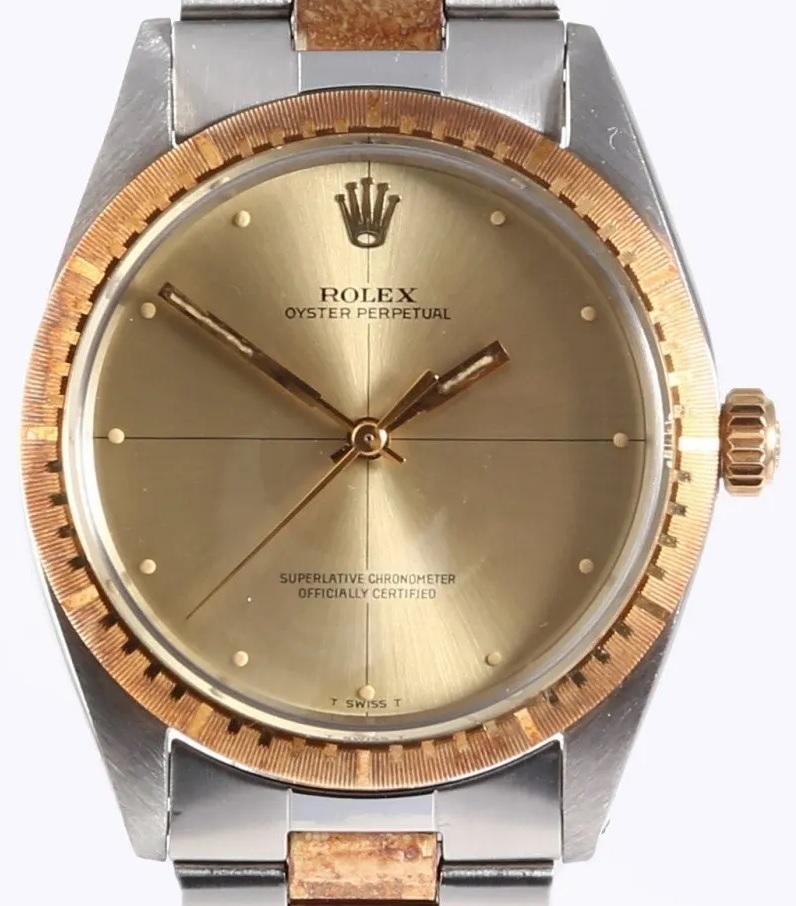
Morellis Bezel
This distinctive Nestle Crunch-like texture is known as “Morellis.”

Chine Bezel
Chine is an interesting pattern of parallel and perpendicular slashes etched into the gold.

Moreau Bezel
Moreau bezels seem almost like a chine texture on top of a Florentine background.

Jute Bezel
Jute appears reminiscent of a crocodile skin texture. Here it is on ref. 1508:

Greek Key Bezel
This unique bezel pattern only appears on ref. 1509.

Décor Moiré Bezel
Décor moiré bezels somewhat resemble a barked bezel that survived a bear fight. They appear on ref. 1514.

Cross-Barked Bezel?
This is one of two bezel textures we can’t even find a name for. It appears on ref. 1513. Let us know in the comments if you know any official or unofficial names for this! In the meantime we’ll just call it “cross-barked” because it resembles a barked texture, but with some perpendicular slashes going on.

Wavy Bezel?
Like the “cross-fluted” bezel above, this “wavy” bezel can only be found on a single 34mm yellow gold Oyster Perpetual Date model. In this case, it’s ref. 1511. And again, let us know if you have heard an established term for this! Rolex nicknames can be very confusing!

Piranha Bezel
The “piranha bezel” is outlandishly rare. It has only been seen on this ref. 1605 discovered by Amsterdam Vintage Watches.

Pyramid Bezel
Rolex’s pyramid bezel is most often seen on the Oysterquartz Day-Date ref. 19028, but it also came on an extremely rare automatic Day-Date, ref. 18018.

Straw/Paille Bezel
The paille bezel (French for “straw”) only seems to appear on the solid gold Oyster Perpetual ref. 1023.

Learn More About Rolex
Rolex’s Supply Chain: Does Demand Really Exceed Supply?
A Guide to Rolex Logo Dials
Top Affordable Alternatives to Rolex
Guide To Rolex Wimbledon Watches
Gem-Set Rolex Bezels
Now that we’ve covered simple Rolex bezels, useful bezels, and exotic textured bezels, let’s get to most impractical Rolex bezels of all–Rolex bezels covered in gems!
Diamond Rolex Bezels
Whether or not diamonds are your thing, Rolex’s gem-setting abilities are undeniably world-class. We’ll try to help you keep all of the Rolex diamond bezel options straight! Rolex has made many fully diamond-set bezels, but they’ve also made a few with diamonds only at every hour or half-hour. Let’s get to those first:
Smooth Bezel with 12 Diamonds
In rare instances, Rolex added diamonds at each hour of a smooth bezel, as seen on this 34mm Pearlmaster from the early 2010’s:

Domed Bezel with Scattered Diamonds
Domed bezels set with scattered diamonds have been an option on 31mm Datejusts since 2010.

Fluted Bezel with 12 Diamonds
In the early 2000’s, fluted bezels were offered with 12 diamonds on some ladies’ models. This style of Rolex diamond bezel didn’t last long.

Pyramid + Diamond Bezel
Some pyramid bezels also have diamonds at each hour marker, as seen on this ref. 19038:

Barked + Diamond Bezel
Ref. 18308 sports a barked bezel with diamonds at each hour.

Now that we’ve covered Rolex’s partially diamond-set bezels, let’s get to their fully iced-out ones:
Round Diamonds (RBR)
RBR, meaning “round brilliants,” is the most common designation for a diamond-set Rolex bezel.

Cartouche Bezels
If a bezel has round diamonds all the way around the bezel except for a “Rolex” plaque at 6 o’clock, that’s called a “cartouche bezel.”

2 Rows of Round Diamonds (RBR)
Rolex offered a striking diamond-set bezel with two rows of round brilliant diamonds on the white gold Daytona ref. 116589. Interestingly, they didn’t give it a different bezel code, so technically its designation is “RBR” just like a typical diamond bezel.

Trapezoidal diamonds (TBR)
TBR means “trapezoidal brilliants.” “Trapeze-cut” means the same thing. TBR models are typically a bit more expensive than RBR (round diamond) versions. Note that these diamonds aren’t quite “square,” but one could be forgiven for using that term. Some Pearlmaster models seem to get the designation “BRIL” for the same kind of bezel.

Trapezoidal Diamonds with 120 Outer Diamonds (BBR)
The BBR bezel is just like the TBR, except with 120 small diamonds around the rim of the bezel. This very overlooked bezel style only seems to come have been offered on the Zebra-dial Datejusts made from 2012-2018.

Large Baguette Diamonds (BR)
“BR” means 24 baguette diamonds. These can be seen on fancy Daytonas like the 116568 BR as well as the Day-Date 18168. Note the thick gold dividers at each hour. Rolex also made a 24-baguette bezel without those gold separators, which can be found on the ultra-rare vintage Daytona 6270.


Sapphire Rolex Bezels
Rolex has made a wide variety of bezels involving almost every color of sapphire.
Dark Blue Sapphires (SAPH)
Ref. 18058 has trapeze-cut blue sapphires all the way around the bezel. The blue day and date discs are also pretty stunning. Bezels fully set with dark blue sapphires can also be seen on some Pearlmasters.


Light Blue Sapphires
In addition to dark blue sapphires, Rolex has also used light blue sapphires, as seen on this Pearlmaster 29.

Alternating Light Blue and Dark Blue Sapphires (SA)
Rolex also experimented with alternating light and dark blue sapphires on the Pearlmaster 34 ref. 81349 SA.

Sapphires with Diamonds at Each Hour (SABR)
A rare white gold Submariner Date released in 2018, the 116659 SABR, has diamonds at each hour with a total of 36 blue sapphires in between. In order to maintain some bezel functionality, the first 9 sapphires are a lighter blue.

Large Baguette Sapphires (SACI)
The sapphire version of the “BR” bezel is the “SACI” as seen on this white gold Daytona ref. 116589.

Alternating Round Diamonds and Sapphires
Most 18148 Day-Dates just have diamonds in the bezel, but some have alternating diamonds and sapphires.

Diamonds with Blue Sapphires at Each Hour (12SA)
“12SA” means there are sapphires at each hour with trapezoidal diamonds in between. This bezel only seems to appear on Daytona 116599 models with pave diamond dials.

Diamonds with Black Sapphires at Each Hour (SANR)
The 116758 SANR has a very similar bezel to that of the 116599 SA above. However, the sapphires are black, there are 3 diamonds between each hour rather than 4, and the 12 o’clock marker gets a triangle shape.

Black Sapphires (SANR)
Only one reference seems to have gotten a bezel set entirely with black sapphires: the exceptionally odd 116199 SANR. Its suggested retail price was $83,850 in 2017.

Yellow Sapphires
Rolex bezels set entirely with yellow sapphires exist as well, but apparently only on the Pearlmaster 29 from the 1990’s.

Orange Sapphires (SACO)
The bezel code “SACO” means “sapphire cognac.” And cognac means orange in this context. In addition to the “Leopard Daytona,” Rolex has also released a couple of rare off-catalog Daytonas with orange sapphire-set bezels in recent years.


Photo credit: Mike Tay
Pink Sapphires (SARO)
Rolex has used pink sapphires on Pearlmasters as well as at least one Daytona model.


Pink Sapphires, Alternating Shades (SARO)
While most SARO bezels have sapphires that are all the same shade of pink, Rolex tried out alternating shades on the Pearlmaster 34 ref. 81348 SARO.

Pink Sapphire Baguettes (SAFU)
The 16588 SAFU is an exceptionally rare Daytona model from the mid-1990’s. No other Rolex model seems to have a bezel set with large pink sapphire baguettes.

Ruby Rolex Bezels
Some people don’t realize that rubies and sapphires are actually the same mineral (corundum). For some reason, we call red corundum “ruby” and every other color “sapphire,” but the line between red and non-red is arbitrary. For example, how pinkish can a ruby be before it’s a “pink sapphire” and not a ruby? In any case, Rolex’s rubies tend to be on the darker side, with distinct bezel codes from their pink sapphire relatives.
Trapezoidal Rubies (TRU/RU)
TRU means “trapezoidal rubies,” and they can be seen on some heavy-hitting Day-Dates like the 18068 from the 1980’s or the recent 228398 TRU. Rolex also released an off-catalog Daytona with pigeon blood rubies on the bezel in 2023, the 126598 TRU.



Large Baguette Rubies (SALV/RUBI)
SALV and RUBI seem to mean the same thing in the world of Rolex bezels–large ruby baguettes! The 16589 RUBI and its successor, the 116589 SALV, are both extraordinarily rare, seen here with grossular dials and 24 large baguette rubies. The 19168 Oysterquartz was offered with a ruby baguette bezel as well, and because it lacks the thick gold dividers at each hour, it has room for 28 baguettes.



Alternating Round Diamonds and Rubies
The rare half-ruby version of the Day Date ref. 18148 looks fantastic with the red Stella dial shown here.

4 Rubies with Diamonds in Between (4RU)
4RU means just what it sounds like–4 rubies. What’s in between the rubies at 12, 3, 6 and 9? Diamonds, of course!

Repeating Pattern of 6 Rubies and 5 Diamonds
This particular bezel, with 24 trapeze-cut rubies and 20 round diamonds divided into 4 segments each, is only found on the Oysterquartz Day-Date ref. 19188. Rolex literature indicates that this bezel configuration was also available with emeralds or sapphires instead of rubies, but no pictures are available of such an example.

Emerald Rolex Bezels
Emeralds are even rarer than rubies–both in the world and in the Rolex lineup!
Square emeralds (TEM/EMRO)
Both Mark Wahlberg and Mirka Federer have been spotted wearing a 228396 TEM with an emerald bezel. Rolex also used a fully emerald-set bezel on a rare Daytona from the late 1990’s, ref. 16598 EMRO.


EMRO (Emerald baguettes)
Even rarer than trapeze-cut emeralds, this Rolex Daytona ref. 16568 sports an emerald baguette bezel.

Trapezoidal Emeralds with Diamonds at Each Hour (EMBR)
8 years before the 116659 SABR, Rolex did pretty much the same thing except with emeralds. The rare 116649 EMBR was an off-catalog 2010 release. Unlike the SABR version, the gems from 0-15 minutes are not different.

Trapezoidal Emeralds with Round Diamonds at Each Hour (EM)
Similar to the EMRO bezel above, the EM bezel (only seen on the Oysterquartz ref. 19198) has diamonds at each hour, with 3 emeralds between each. The only difference here is that the diamonds are round-cut.

Alternating Round Diamonds and Emeralds
Ref. 18148 came usually came with an all-diamond bezel, but some rare variants with alternating emeralds and diamonds turn up every once in a blue moon.

8 Trapeze-Cut Gems at the Top and Bottom, 15 Round Diamonds on Each Side
The Rolex Oysterquartz Day-Date ref. 19178 is the only model that seems to have gotten this bezel configuration: 8 square-cut gems at the top of the bezel, 8 square-cut gems at the bottom, and 15 round diamonds on each side. Rolex supposedly made this reference with 3 different gem options–rubies, sapphires, or emeralds–but only this emerald version has surfaced. This might be the most rare Rolex Oysterquartz bezel of all.

Combinations of 3+ Gems
We’ve now covered Rolex’s ruby bezels, emerald bezels, and sapphire bezels. We’ve also covered bezels featuring those types of gems along with diamonds, as well as bezels with just diamonds. But there have been several times where Rolex used at least 3 distinct gem types on a single bezel.
Rolex Rainbow Bezel (RBOW) Sapphire Gradient
Rolex’s now-discontinued Rainbow Daytona gets a lot of hype (and high resale prices) these days, but it wasn’t Rolex’s first watch with a rainbow sapphire bezel. At least 5 or 6 of its “sapphires” should really be called “rubies,” but nevertheless Rolex refers to its bezel as having “36 baguette-cut sapphires in a rainbow gradation.”
Rolex made an Oysterquartz with a rainbow bezel (ref. 19078) in the 1980’s, as well as a rainbow Datejust in ladies’ size (ref. 69118).



Non-Rainbow Sapphire Gradient
In addition to rainbow bezels, Rolex has also made some sapphire-set bezels with more subtle gradients. Oysterquartz 19158’s have gradients like green-to-yellow, whiteish-to-purple, and auburn-to-yellow. The Pearlmaster 39 was offered with 3 different sapphire gradients from 2015-2020: SABLV (blue-to-yellow), SAJOR (yellow-to-red) and SAFUBL (purple-to-blue). With the Rainbow Daytona being discontinued as of 2023, there are no more sapphire gradients in the current Rolex lineup.




Iced-Out Pepsi Bezel (SARU)
SARU means sapphires and rubies–the “iced out” version of a Pepsi bezel! SARU GMT’s have now been made in all 3 colors of gold, with and without pave diamond dials. While 6-digit versions have sapphires for the top half, the 16758 SARU has them at the bottom.


Bruce Wayne Bezel (Blue Sapphires/Black Sapphires)
“SABLNR” means blue and black sapphires. The 116749 SABLNR has been called the “Bruce Wayne,” as it is essentially the “iced out” version of a Batman (blue and black) bezel.

Sprite With Ice (Emeralds/Black Sapphires)
In 2023, Rolex quietly added an off-catalog “Iced-Out Sprite” GMT with emeralds and black sapphires on the bezel.

Coke With Ice (RUSA, Black Sapphires/Rubies)

The same year as the “Sprite With Ice” came the “Coke With Ice,” ref. 126758 RUSA in yellow gold. It’s similar to a SARU, but with black sapphires instead of blue.
Candy Crush/Haribo Bezel(SATS)
A special off-catalog rose gold Yacht-Master 40, Rolex Yacht-Master ref. 116695SATS, appeared in 2017. It has been called the “Candy Crush,” “Tutti Frutti” and “Haribo” because of its colorful sapphire bezel pattern.

Cotton Candy Bezel (SABR)
In 2022, 5 years after the Haribo, Rolex unveiled another colorful sapphire bezel for an off-catalog precious metal Yacht-Master 40. The 126679 SABR is often called the “Cotton Candy Rolex.”

Alternating Square Rubies, Emeralds, Sapphires and Diamonds
Years before the off-catalog gem-set Yacht-Masters, Rolex tried a colorful alternating pattern of gems on the Day-Date 18188a.
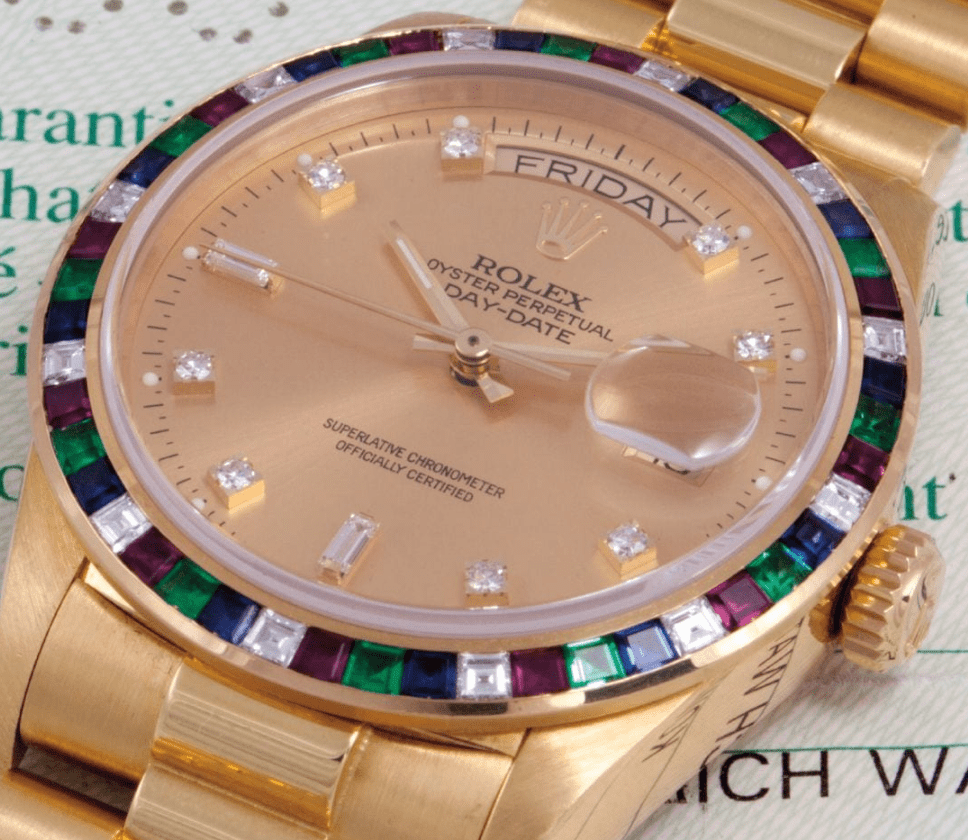
Alternating Triangular Rubies, Sapphires and Emeralds
Only one Rolex has been seen with an alternating pattern of triangular rubies, sapphires and emeralds: collector Walter Yeung’s Day-Date 18178.

Well, that’s all the bezel types we can think of. We hope you enjoyed our guide to Rolex bezels. Leave us a comment if we missed one!
Rolex Buying Guides
How Does The Rolex Waiting List Work?
How to Spot a Fake Rolex
Guide to Rolex Serial Numbers
How Many Links Does a Rolex Come With?
How to Sell My Rolex Watch
2 responses to “Rolex Bezels: The Ultimate Guide”
-
My 40 mm rolex bezel has inner beveled teeth on the inside back
It is stamped 2 times on the back edge with the rolex crown. Is it possible to send you an image of this you could let me know what model it is and rarity.-
Sure Kevin, I’ll shoot you an email right now.
-






Leave a Reply